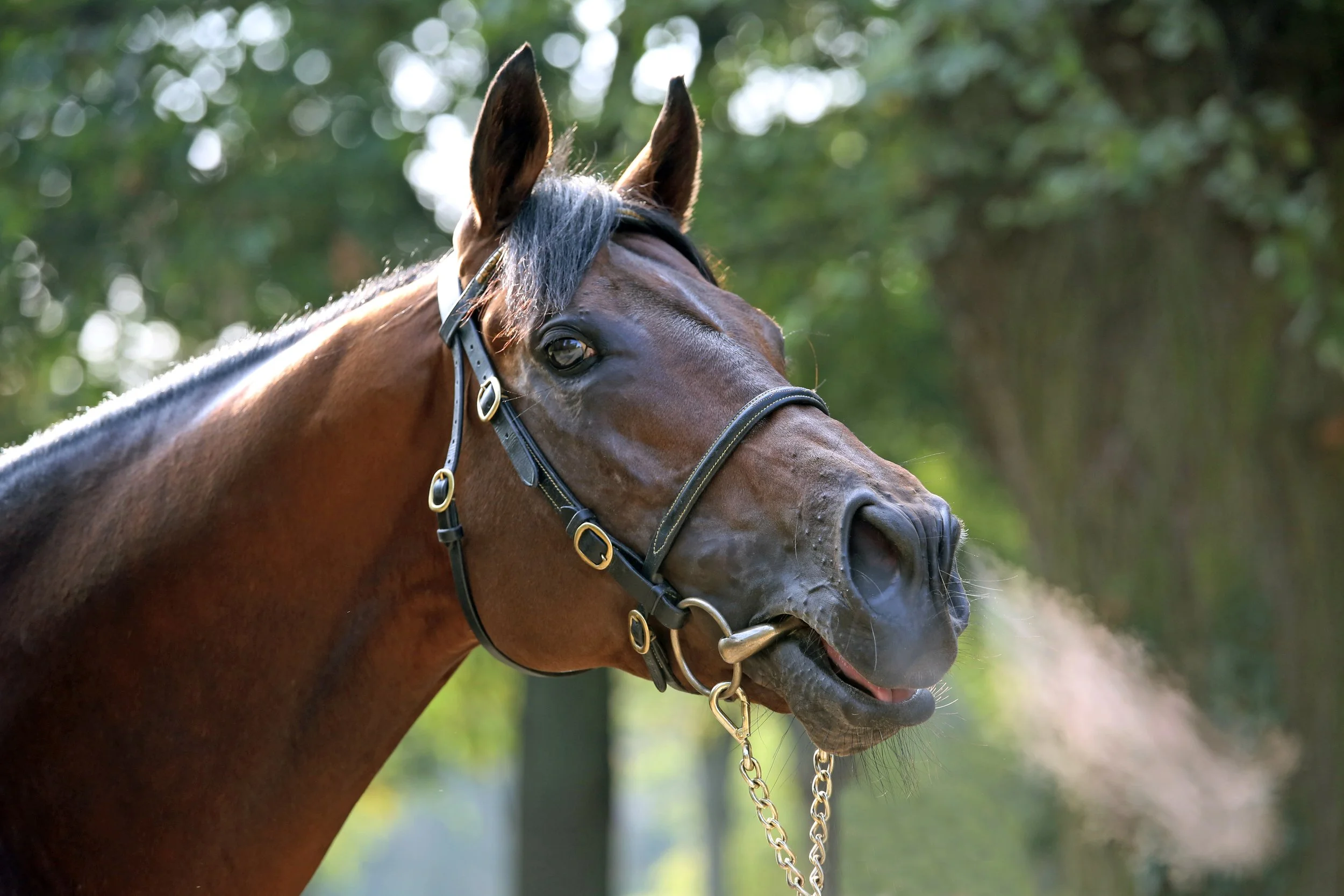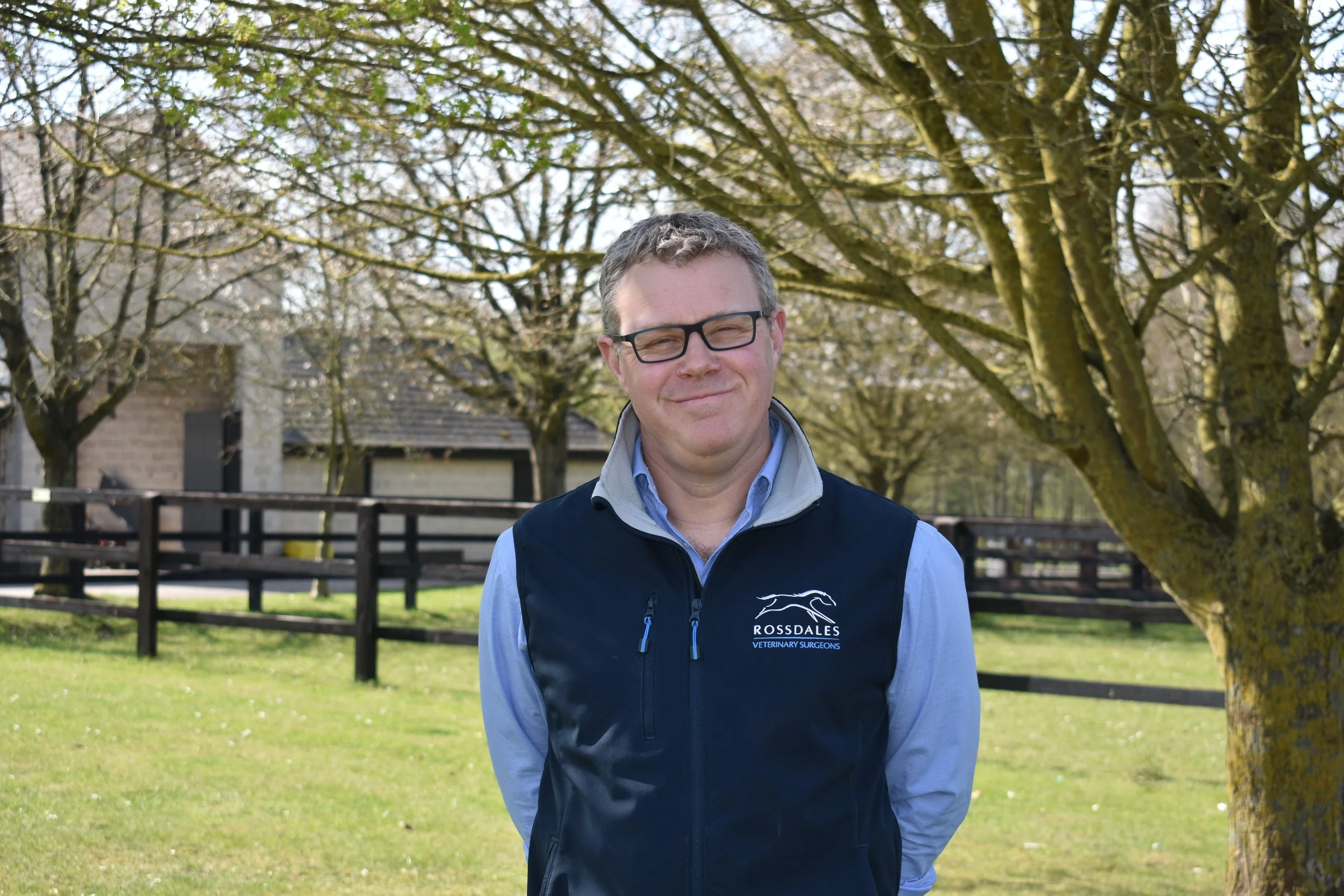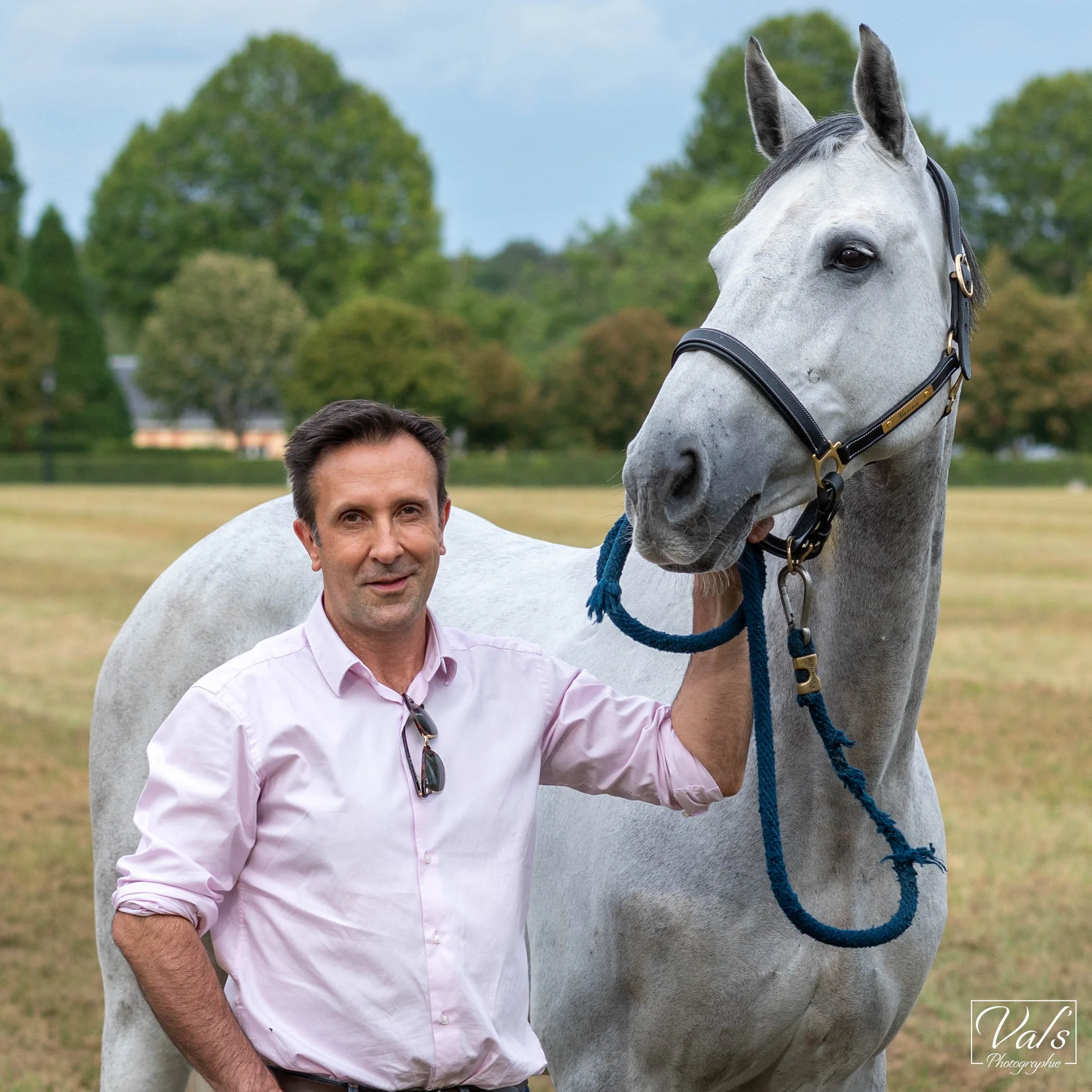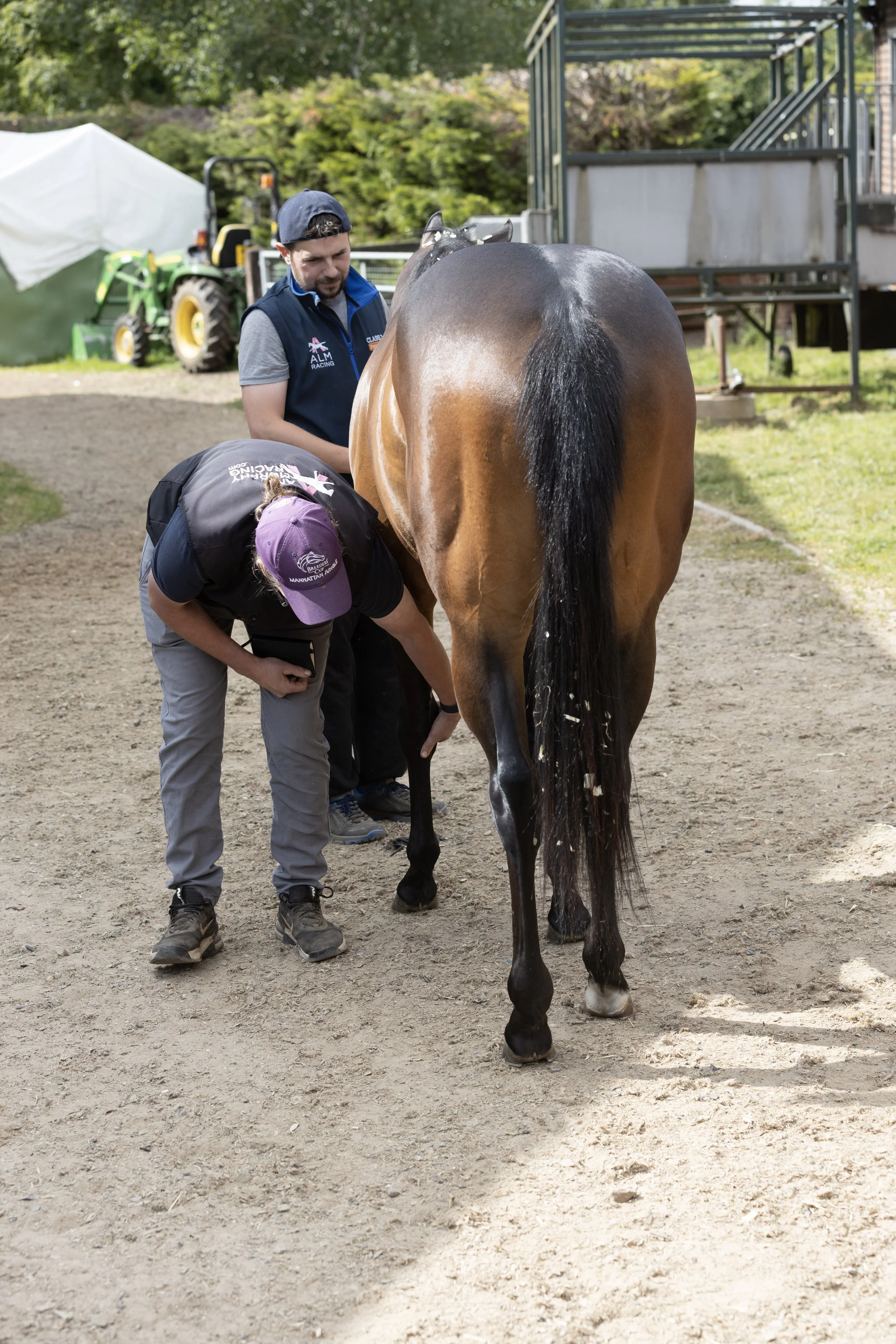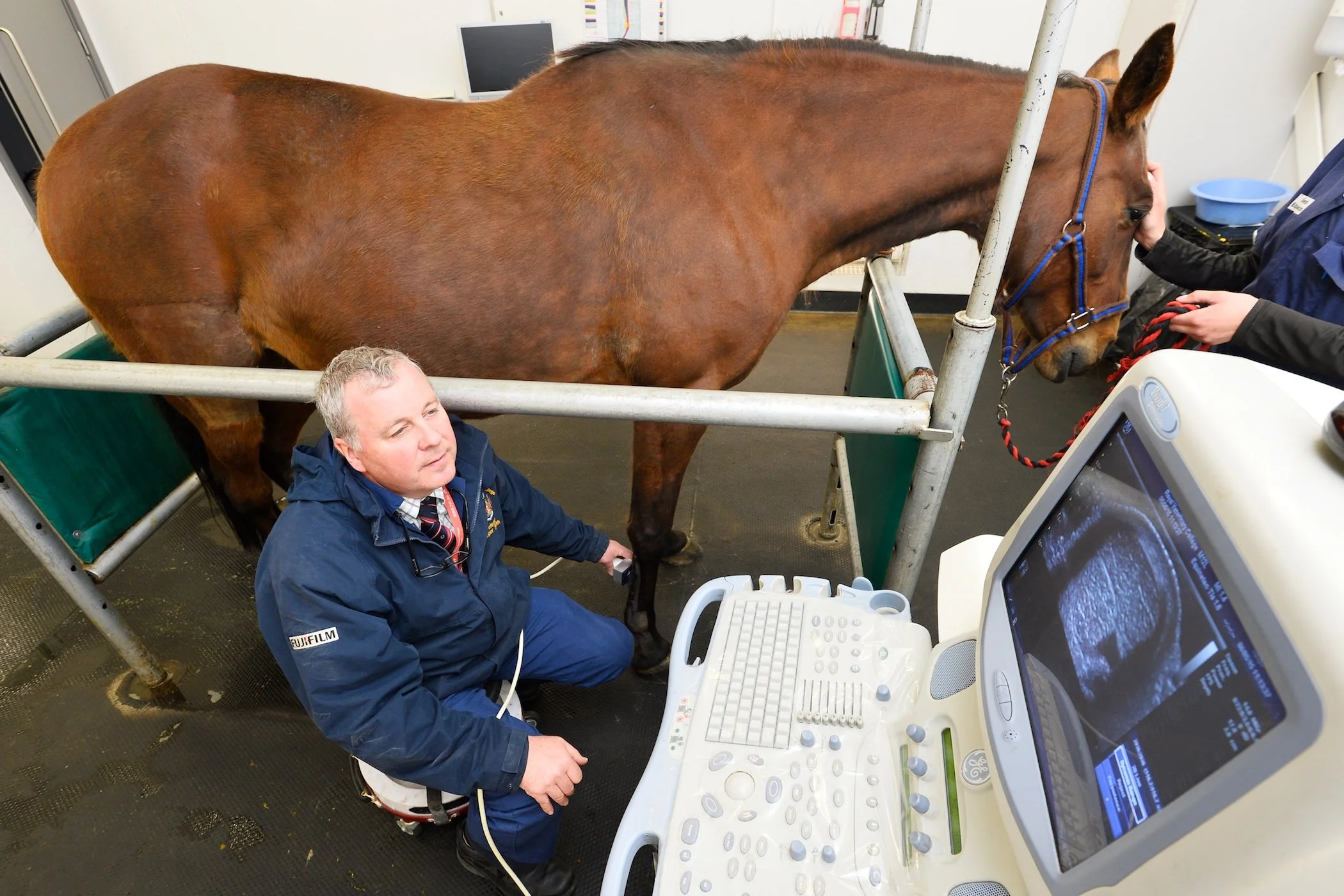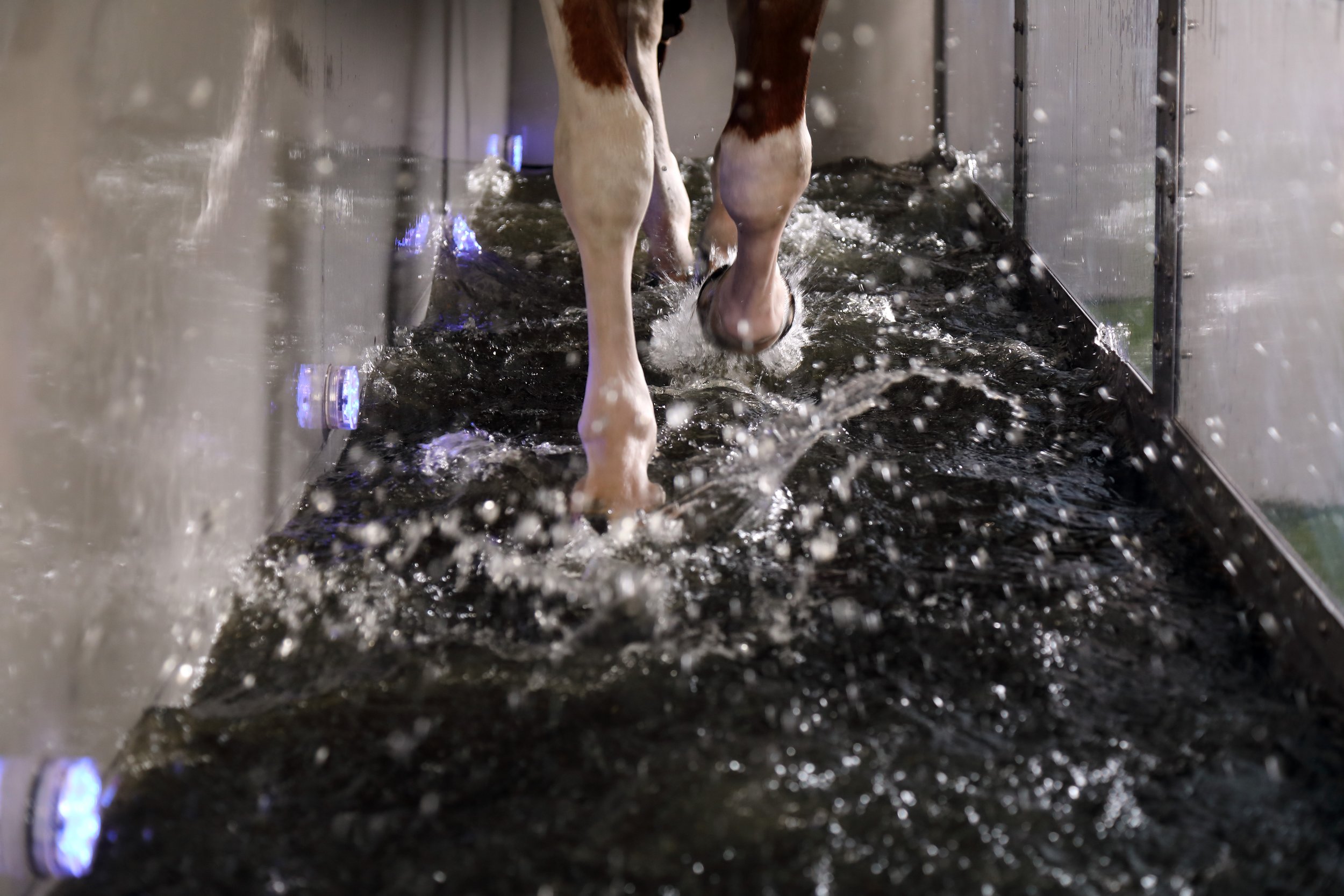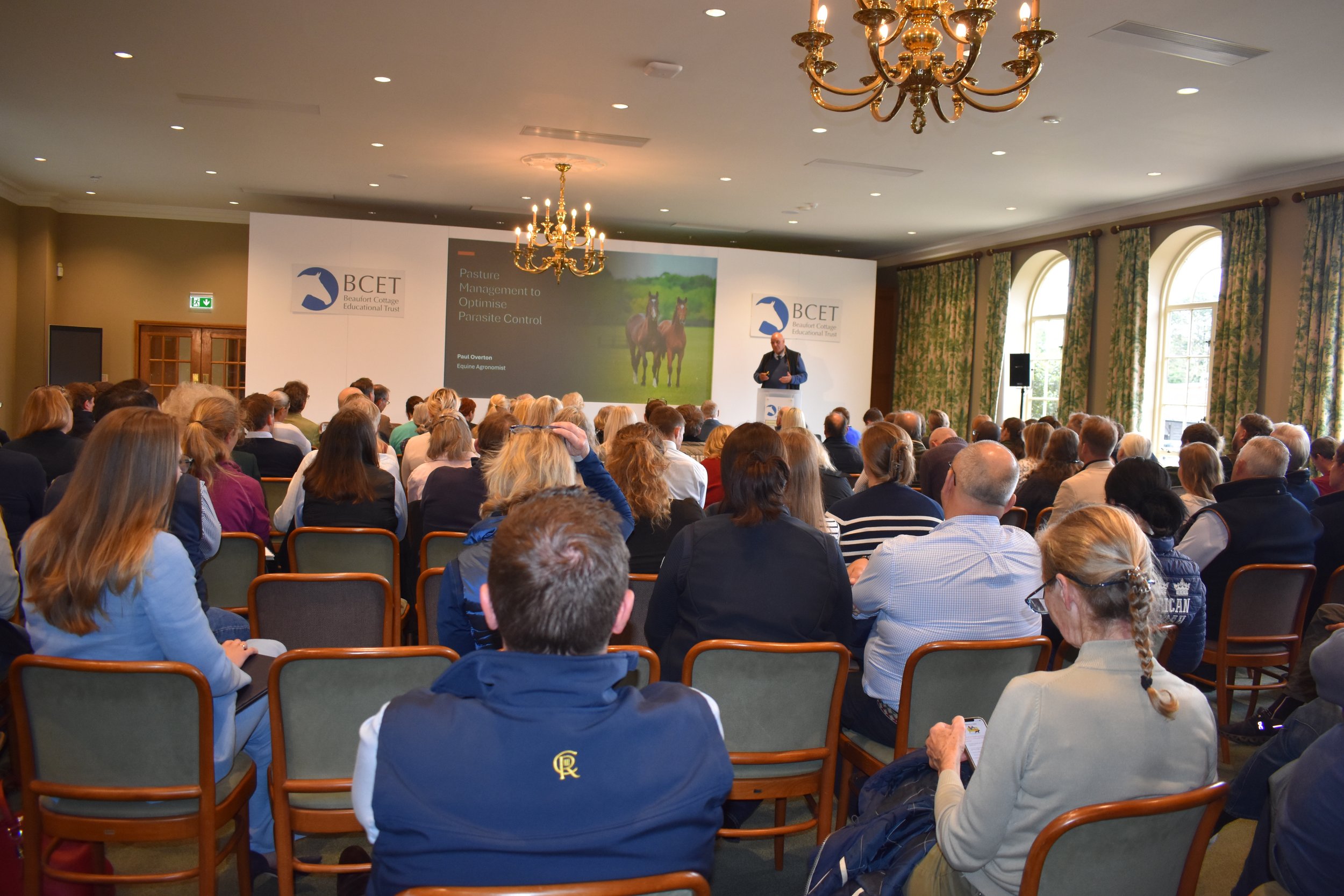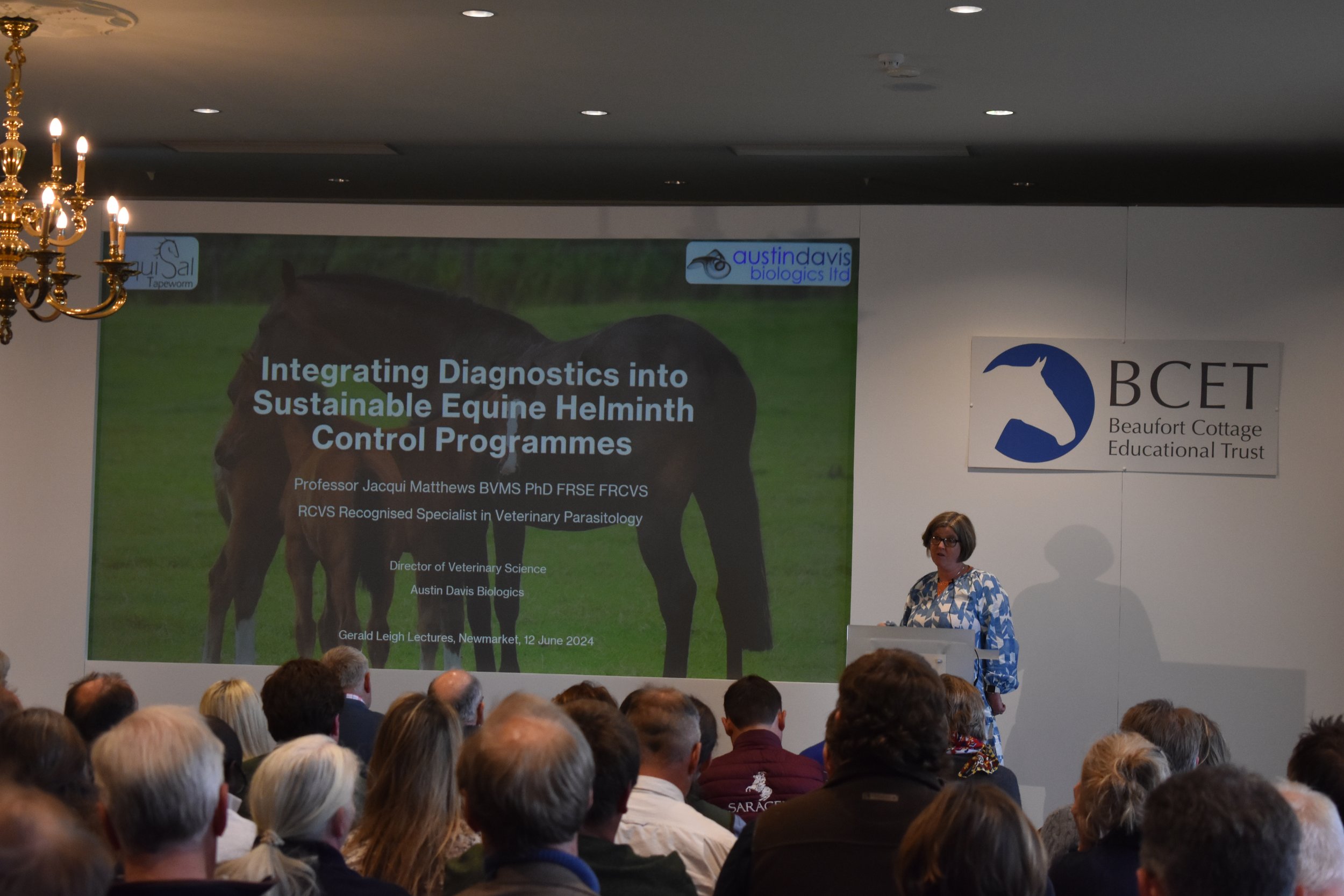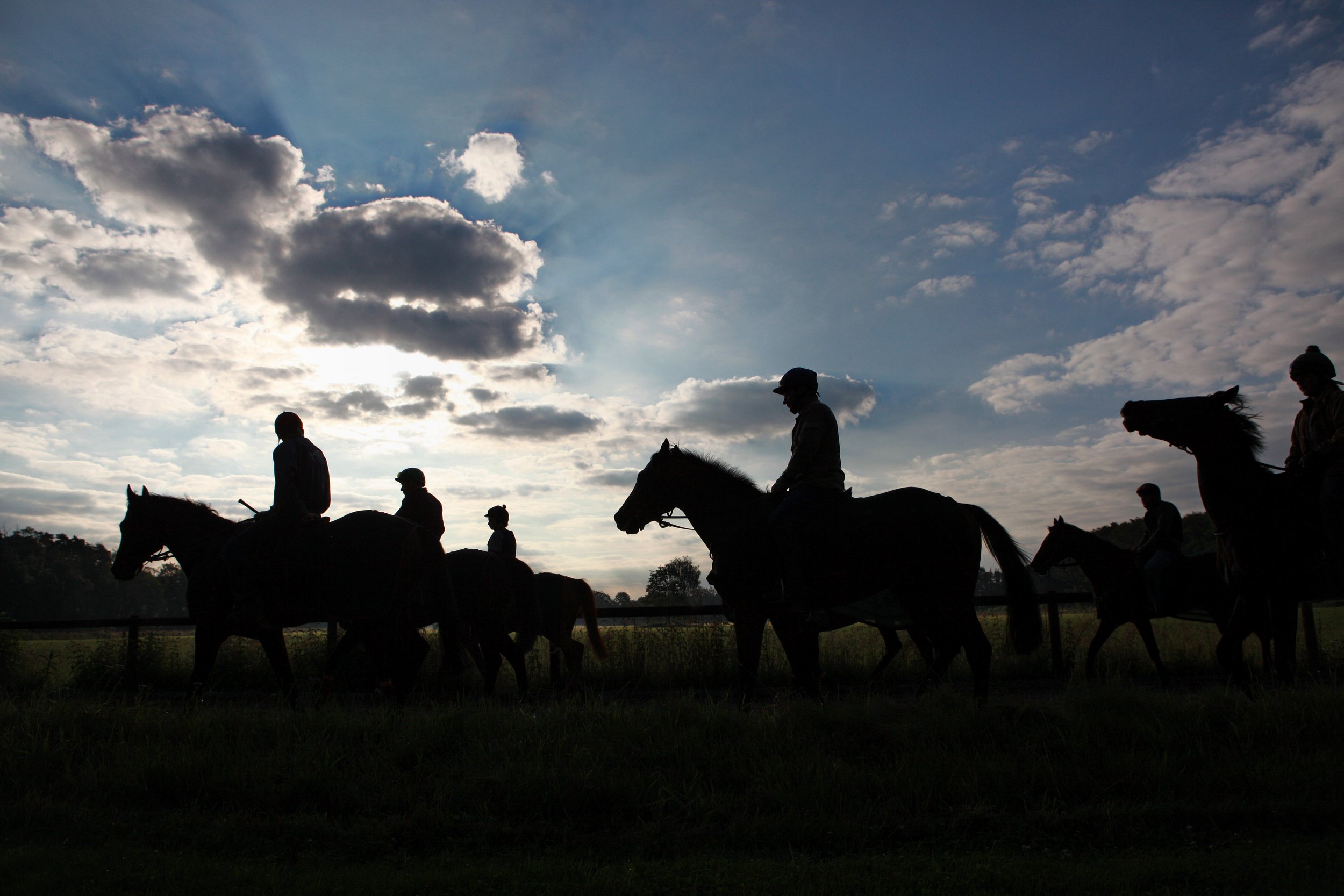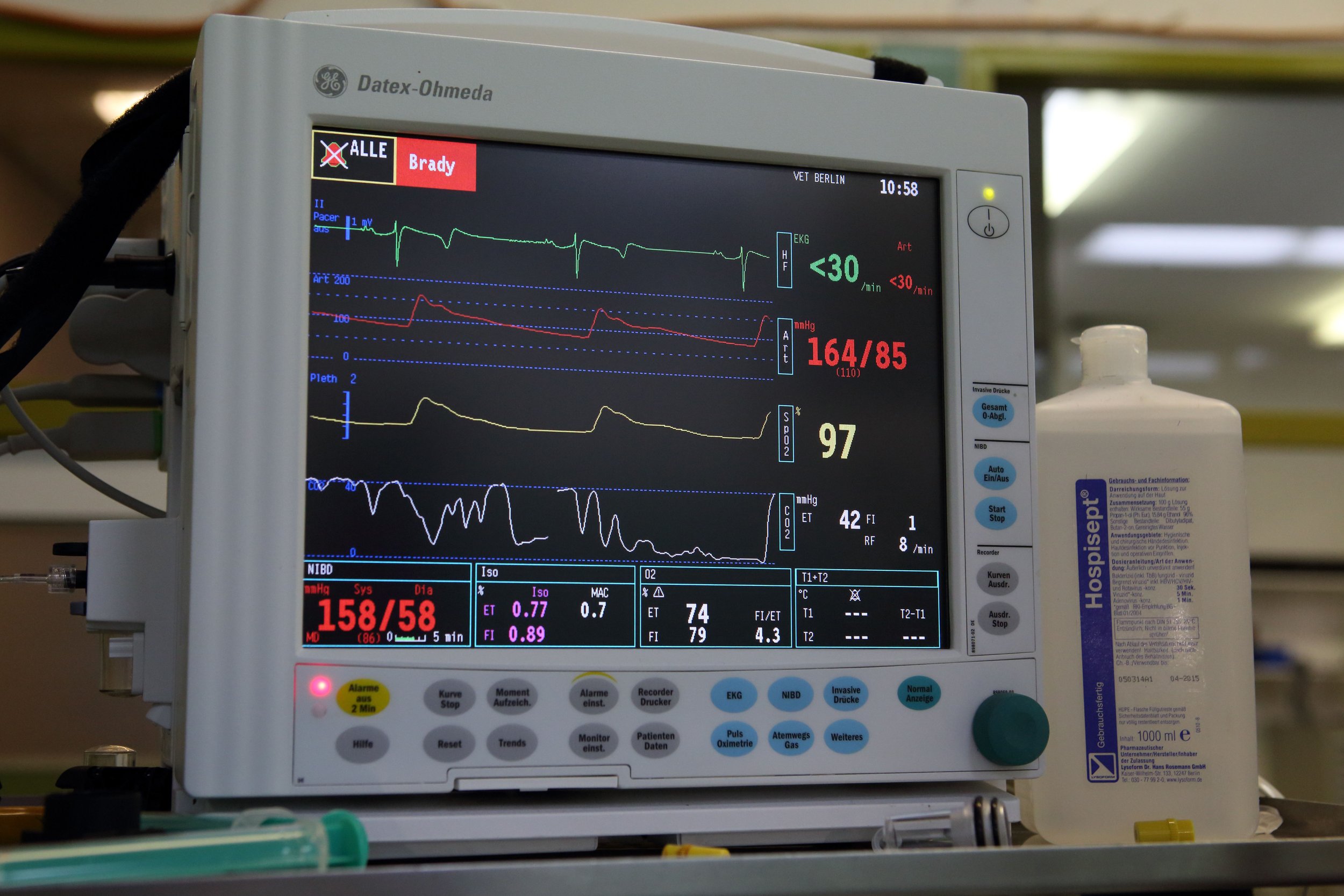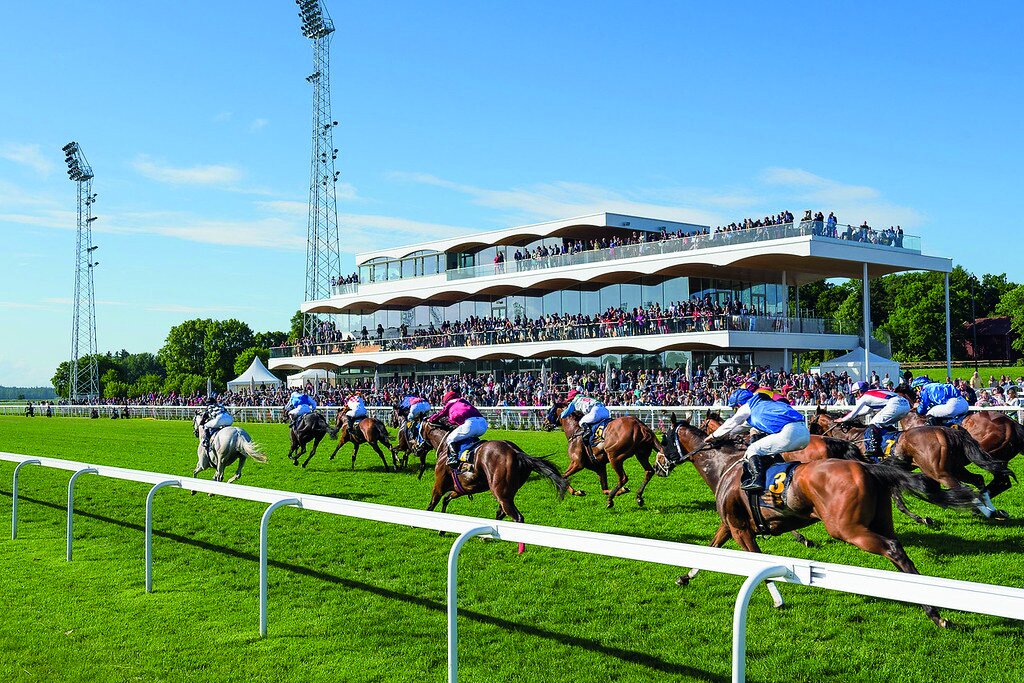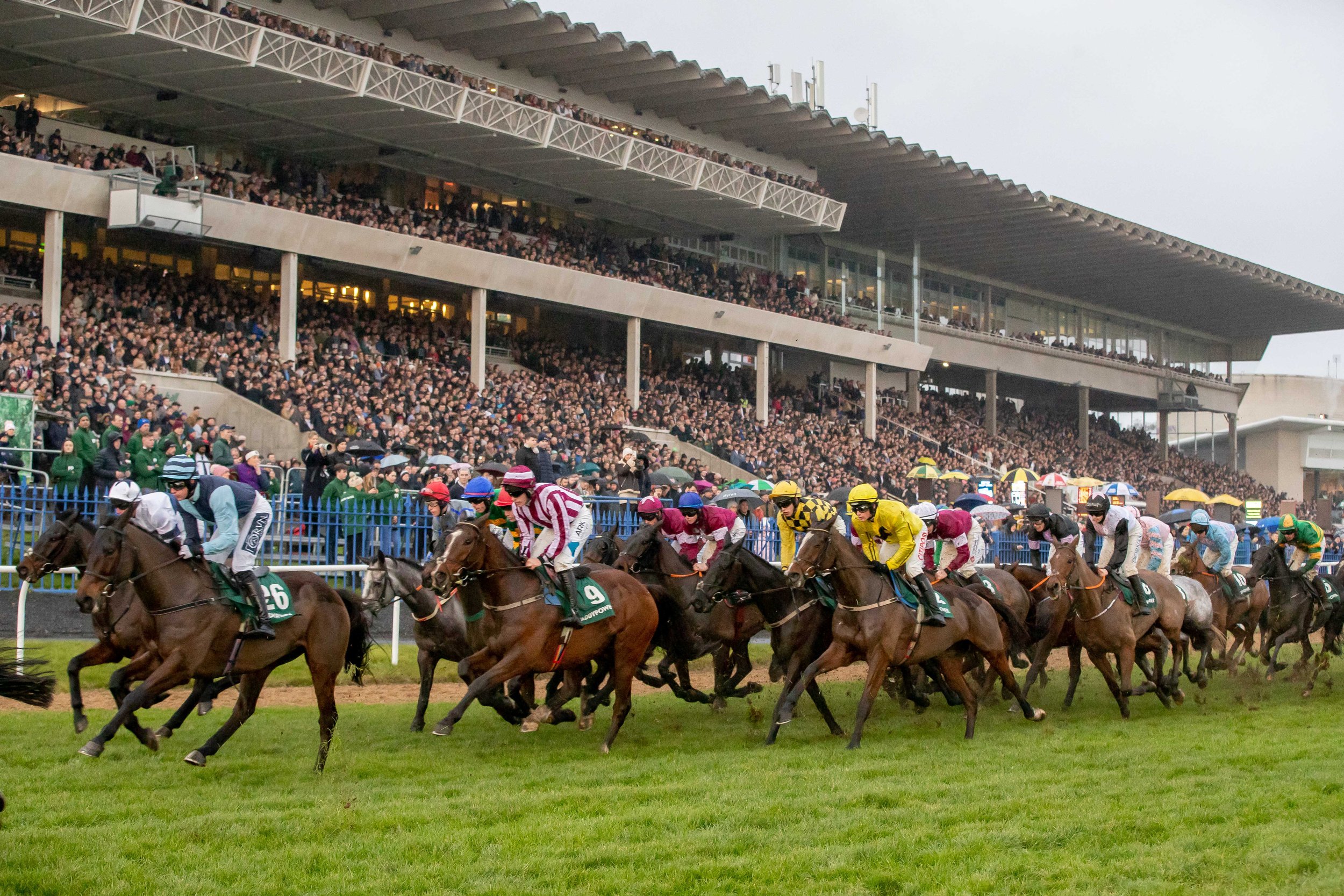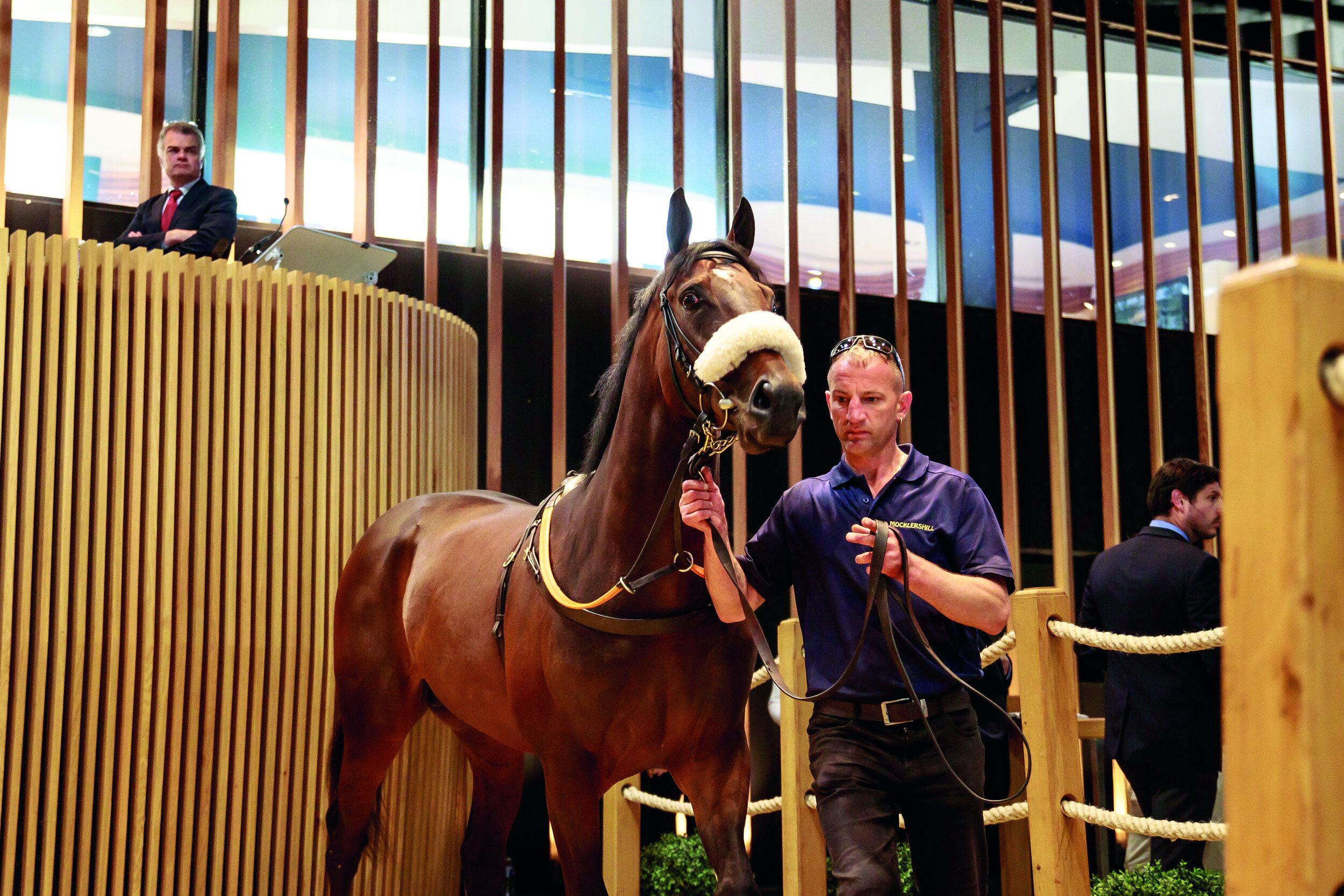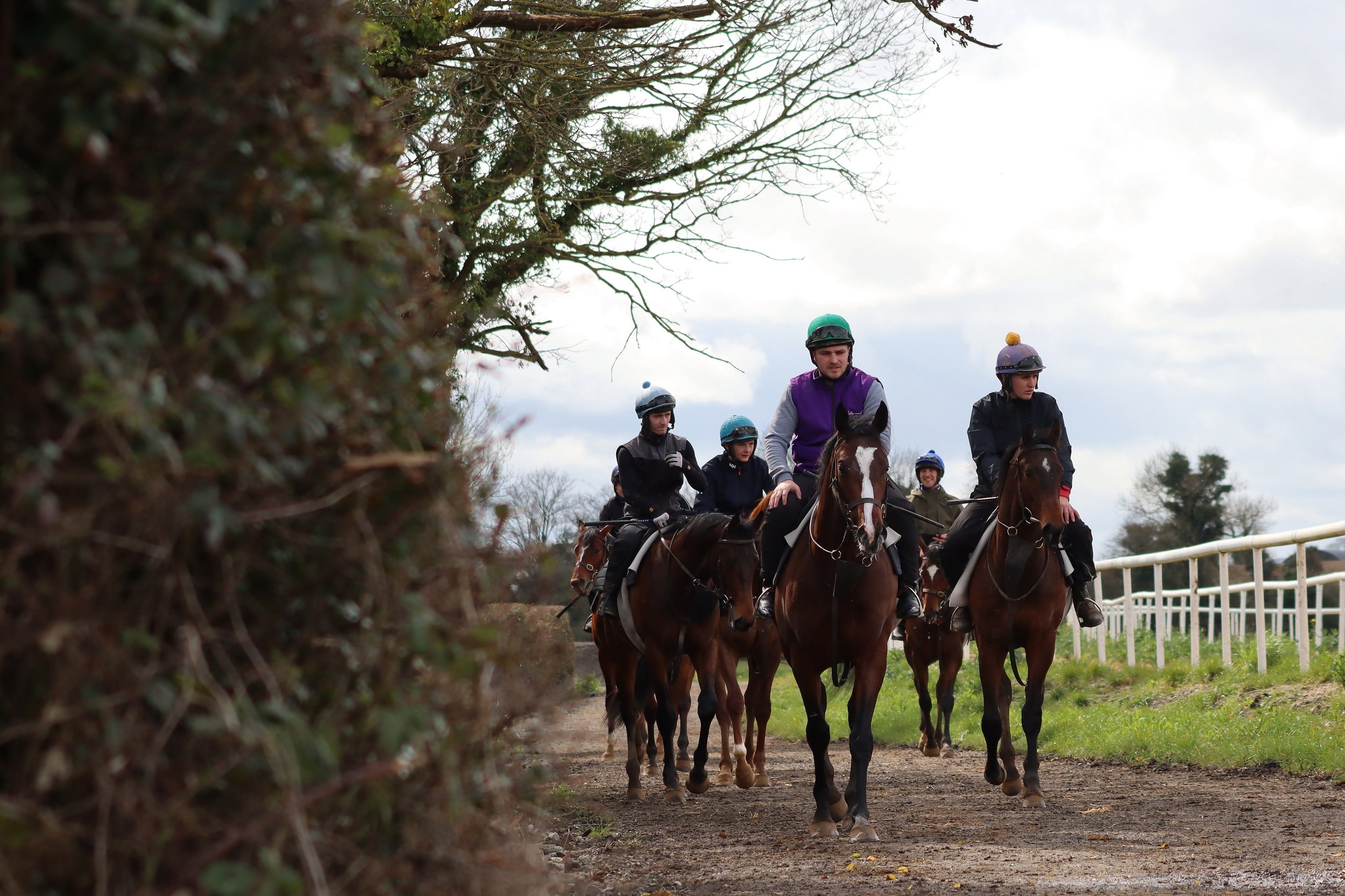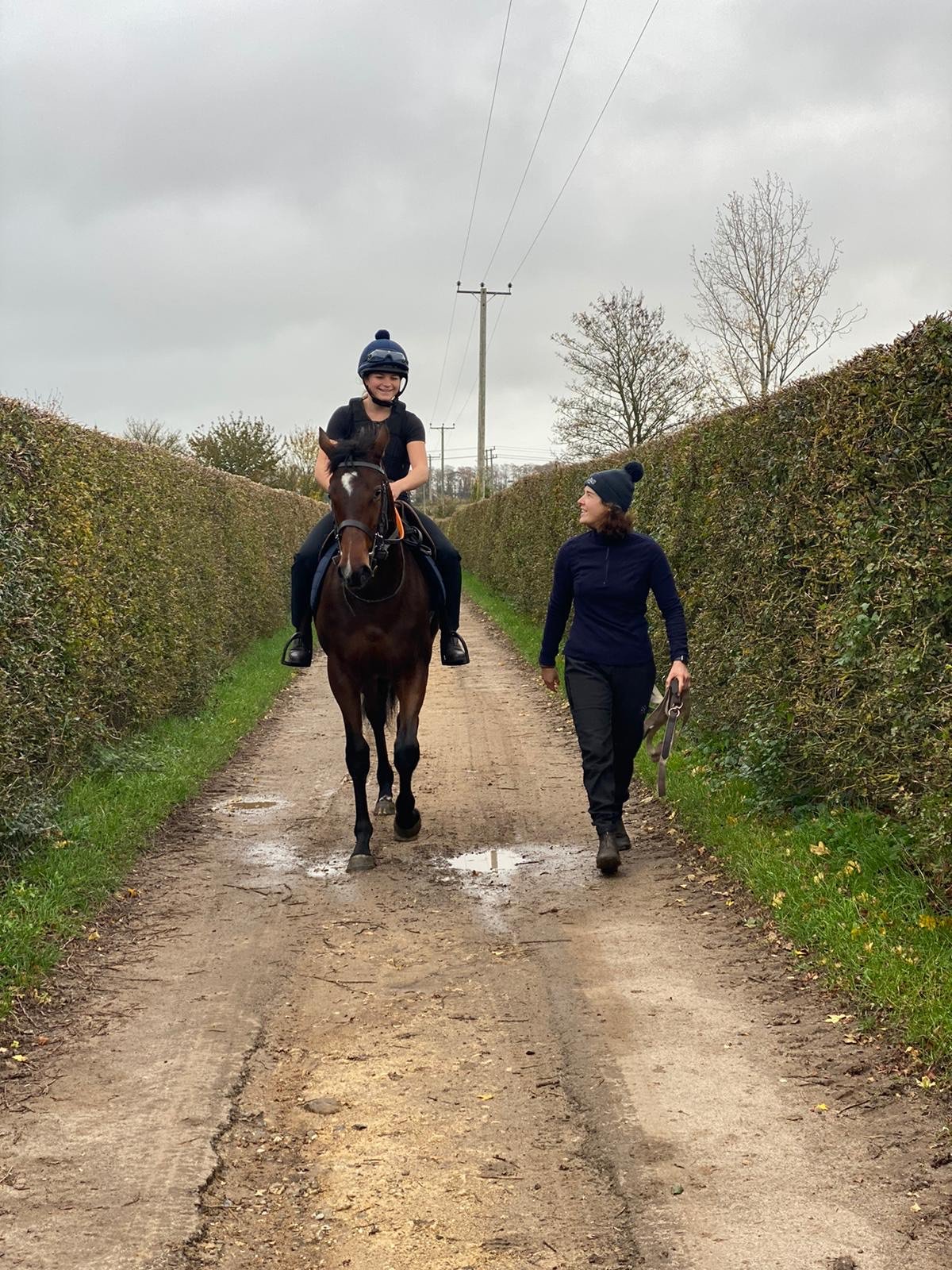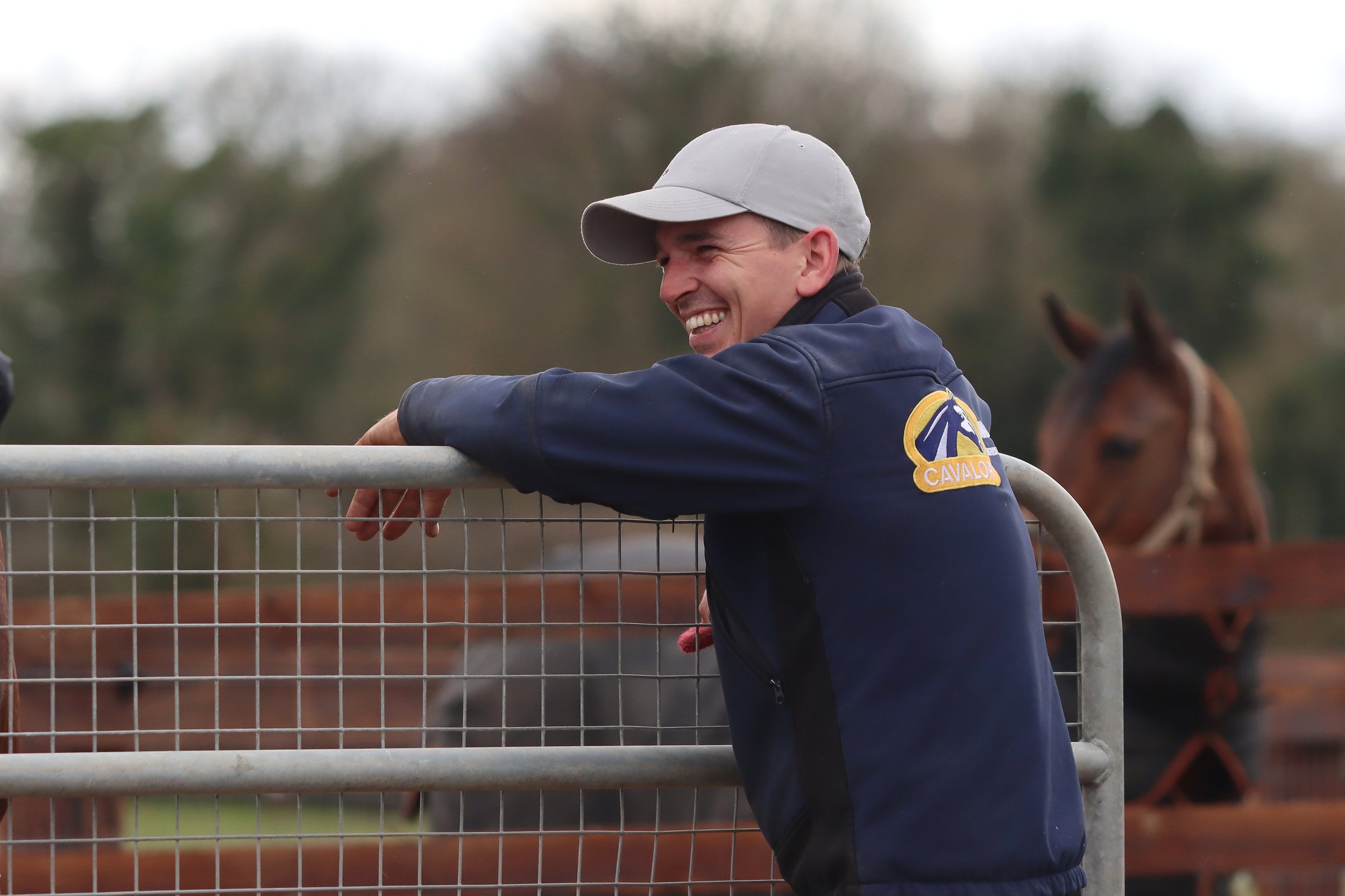Gerald Leigh Memorial Lectures 2025
The seventh renewal of the Gerald Leigh Memorial Lectures, in association with Beaufort Cottage Educational Trust took place at Tattersalls in Newmarket, England on June 4th.
The Gerald Leigh Charitable Trust was established in 1974, set up in memory of Gerald Leigh, a prominent owner breeder and best known for breeding the highly successful Barathea and Markofdistinction.
His legacy lives on through the trust, which not only reflects his remarkable achievements and lasting influence in the world of Thoroughbred breeding and racing, but also continues his deep passion for scientific advancement and the welfare of horses—both within the racing industry and the wider equine community. The trust stands as a testament to Gerald Leigh’s enduring commitment to excellence, care, and innovation in all aspects of equine life.
Wind ops- the decision making and diagnostics
Tim Barnett MRCVS of Rossdales Veterinary Surgeons, delivered two informative and interesting lectures on wind ops and the decision making and diagnostics relating to them. As we all know, wind surgery addresses upper airway conditions in horses that impair breathing and performance. Key anatomical structures involved include the arytenoid cartilage, vocal folds, epiglottis, and soft palate. Common issues include vocal fold collapse, often causing a whistling noise and linked to progressive recurrent laryngeal neuropathy “roaring”, which severely obstructs airflow. Another frequent problem is dorsal displacement of the soft palate (DDSP), where the soft palate flips over the epiglottis, blocking airflow and causing sudden loss of performance.
Palatal instability often precedes DDSP. Other conditions include medial deviation of the aryepiglottic folds, nasopharyngeal collapse, epiglottic entrapment, and ventral luxation of the arytenoid apex (VLAC). These disorders vary in severity and may be progressive or multifactorial. Barnett clarifies that although surgical interventions target these conditions, outcomes depend on the specific disorder and severity.
Upper airway conditions remain a major cause of poor performance in racehorses, with many requiring multiple surgical interventions. Accurate diagnosis, particularly via exercising endoscopy, is key, as many disorders only become apparent during physical exercise.
Tieback (prosthetic laryngoplasty) is the most common wind surgery but carries risks such as aspiration, pneumonia and swallowing dysfunction, despite efforts to improve surgical techniques. Newer techniques, like standing tiebacks and improved implants (e.g., titanium buttons, reinforced screws), aim to reduce complications and enhance results.
Other surgeries like Hobday (vocal fold removal via laser) were also discussed, emphasising the delicate nature of airway surgeries and the ongoing challenge to balance treatment effectiveness against risks and complications in our racehorses.
For DDSP, tie-forward surgery, which mimics natural muscle action to restore laryngeal position, has shown positive results, while thermocautery remains controversial. Epiglottic entrapment can now be safely corrected in standing horses using lasers or scissors. Emerging therapies include laryngeal reinnervation and dynamic neuroprosthesis to restore muscle function, as well as vocal fold filling to reduce aspiration pressure.
Collagen cross-linking is also under investigation as a less invasive method for soft palate stiffening. Barnett concludes, precise diagnosis and tailored interventions are crucial for optimal results in treating upper airway disorders in racehorses. These advances reflect a growing push for safer, more effective airway interventions in the racehorse.
Barnett then moved onto discussing the critical role of exercise endoscopy in diagnosing upper airway dysfunction in Thoroughbreds, highlighting the limitations of resting endoscopy. While useful for detecting conditions like total RLN, epiglottic entrapment, or arytenoid chondritis, resting scopes often miss dynamic issues such as soft palate disorders and vocal fold collapse.
Recent developments in overground endoscopy which are battery-powered and rider-compatible, allow evaluation during real time exercise, providing accurate and practical diagnosis. This method has become the preferred standard, especially for assessing palatal instability and early RLN.
Clinical signs such as respiratory noise, poor performance, or sudden stops may indicate airway dysfunction, but accurate diagnosis requires proper exercise testing with horses cantering or galloping while synchronising breaths per stride. Additional tools like laryngeal ultrasonography aid diagnosis and planning of treatment.
Barnett cautioned against performing airway surgery without thorough diagnostics, as multiple simultaneous conditions can exist, and treatments must be carefully targeted to improve outcomes. Around 25% of Thoroughbreds show clinical RLN, reinforcing the need for tailored, evidence-based treatment plans to support both welfare and performance.
Laryngeal surgeries - the evolution of research and engineering of the tie back and nerve graft
Dr Fabrice Rossignol, of Grosbois/Chantilly Equine Clinic discussed laryngeal surgeries, focussing on the evolution of research and engineering of the tie back and nerve graft. Rossignol’s specialist clinic is at the forefront of treating recurrent laryngeal neuropathy (RLN).
The condition is often linked to degeneration of the recurrent laryngeal nerve, affecting the cricoarytenoideus dorsalis (CAD) muscle, which is critical for opening the airway during exercise. Rossignol explains that this muscle contains few fatigue-resistant fibres, making it vulnerable to atrophy. Even minor narrowing of the airway significantly increases resistance, due to the exponential pressure effects described by Poiseuille’s law.
Diagnosis involves treadmill endoscopy and ultrasonography (caudal view of swallowing can be particularly useful) to assess dynamic airway collapse and muscle atrophy. Treatment is tailored to severity; advanced cases may require a tieback (laryngoplasty) using synthetic prostheses to partially open the arytenoid cartilage, though this risks complications like coughing. Newer techniques aim to restore function rather than replace it. One such innovation combines traditional tieback surgery with nerve grafting from the spinal accessory nerve, which activates during inspiration and contains fatigue-resistant fibres.
This hybrid approach improves airway opening and reduces side effects. Standing surgery under sedation allows more precise suture placement, minimising anaesthetic risk. Emerging technologies like 3D-printed implants and titanium screw anchors further enhance outcomes. Rossignol echoes Barnett’s earlier advice, that early intervention and careful case selection remain key to success.
Dr Rossignol continued on to discuss what and how we, as a racing industry, can learn from other disciplines.
Recent research in trotters and sport horses highlights how neck flexion contributes to dorsal and lateral pharyngeal collapse, likely due to nerve inflammation affecting muscles such as the stylopharyngeus. Nasal obstruction, including alar fold collapse and nasal muscle paralysis, also play a role in compromised airflow. Treatment options now include alar fold resection, nasal fenestration (widening), and innovative approaches like titanium mesh implants to replace lost muscular function.
Dr Rossignol explains that high-speed treadmill testing has proven critical in diagnosing dynamic airway conditions, while a multidisciplinary approach involving vets, trainers and farriers enhances management strategies. Use of nasal dilation devices, such as nasal strips, remains restricted under many jurisdictions' rules of racing.
It is clear that Rossignol champions cross-disciplinary learning, working with trotter trainers over decades has yielded practical insights, such as shoe removal to enhance performance. The methodical, detail-driven tack and equipment adjustments made in trotting disciplines provide valuable lessons in optimising performance.
Dr Rossignol also shares advances in surgical techniques, including refined approaches to epiglottic entrapment, emphasising the importance of collaborative care. Cross-disciplinary exchange continues to inform diagnosis, treatment and rehabilitation, enriching equine sports medicine and improving outcomes across disciplines.
An update on wind surgeries: what's new?
To conclude the lectures on wind ops, Mark Johnston, Dr Rossignol and Tim Barnett took to the floor to field audience questions. The discussion focused on recurrent laryngeal hemiplegia (RLN) in horses, highlighting its probable hereditary component but unclear linking between particular genes. Experts note the complexity of breeding influences and caution against oversimplifying genetic causes, as RLN will most likely be linked with other traits.
Surgery helps individual horses but may skew breeding populations, as generally only the more expensive stallions receive treatment. Disclosure of surgeries before breeding is debated but difficult to enforce. Non-surgical solutions like resistance masks are emerging but their impact on reducing surgery isn’t yet clear. Overall, understanding and managing RLN’s genetics and treatment remain challenging and unresolved.
Early diagnosis of recurrent RLN relies on ultrasonography to detect early muscle atrophy; surgery is recommended promptly to prevent irreversible damage. In contrast, dorsal displacement of the soft palate (DDSP) often stems from muscle fatigue, immaturity, or inflammation and is best treated medically with training and reinforcement until at least three years old. Surgery is a last resort if medical management fails.
Multiple surgeries can be ethical if done safely and explained clearly. Yearling wind testing is variable and challenging to interpret, complicating sales disclosures. The increase in buyers scoping foals’ pre-sale is seen as an invaluable and unpleasant practice due to solid evidence that a foal’s laryngeal physiology will and can change tremendously as they mature. Ongoing research explores novel therapies such as pacemakers and magnetic stimulation.
The practical management of tendon rehabilitation
There is no introduction needed for Mark Johnston, who kindly provided us with his insight on the practical management of tendon rehabilitation. A renowned trainer with decades of experience offered a pragmatic view on tendon injury rehabilitation in racehorses, challenging long-held optimism around recovery. Despite advancements in ultrasound imaging and a range of therapies, from anti-inflammatories to experimental interventions like carbon fibre implants, he is yet to witness a truly successful long-term return to peak performance in top-level racing following a diagnosed tendon injury.
While ultrasound provides valuable detail, he still relies most on visual and tactile assessment, particularly tendon profile and signs of ‘bowing,’ which he considers a critical turning point. In his experience, few flat horses make a full comeback; many may race again, but recurrent issues and shortened careers are the norm. Mark’s approach is rooted in realism: throw everything anti-inflammatory at the injury early, manage workload carefully, and temper expectations.
Long rest alone is rarely effective and controlled rehab and early, aggressive treatment are key. He notes that previous use of prophylactic anti-inflammatories post-race helped reduce injuries, and questions whether restrictions on racecourse treatments may hinder progress. Prevention, early detection, and practical management remain the trainer’s most reliable tools.
Tendon injuries in racehorses
Professor Roger K.W. Smith FRCVS presented a detailed lecture on tendon injuries in racehorses, focusing on the superficial digital flexor tendon (SDFT) and the role of science in improving prevention and rehabilitation strategies. As a key structure for locomotion, the SDFT functions as an energy-storing spring but operates near its mechanical limits, especially in Thoroughbreds, making it prone to injury from accumulated loading rather than acute trauma.
Research shows that degeneration often precedes clinical injury, particularly within the interfascicular matrix (IFM), which loses elasticity with age and training. Tendon cells also become less responsive with age, impairing repair. Matrix metalloproteinases (MMPs) are implicated in post-exercise matrix degradation, further weakening the tendon.
Professor Smith emphasised prevention through training adjustments: avoiding hard ground, spacing out intense work, and ensuring sufficient recovery of, ideally 72 hours. Early detection is critical. Diagnostic tools such as ultrasound, Doppler, and Ultrasound Tissue Characterization (UTC) can identify structural changes before injury becomes apparent.
When injury occurs, a prolonged, structured rehabilitation programme guided by regular imaging is essential. Biologic therapies like mesenchymal stem cells (MSCs) and platelet-rich plasma (PRP) are showing encouraging results, improving tendon structure and reducing re-injury rates. A personalised, biologically informed approach remains key to safeguarding tendon health in racehorses.
Tendinopathy - its causes, treatments and parallels between equine and human medicine
Lt. Col. Dr Tom Clack delivered a comprehensive lecture on tendinopathy, highlighting its causes, treatments, and parallels between equine and human medicine. Tendinopathy, a chronic overuse injury, follows a three-stage progression: reactive tendinopathy (early inflammation), tendon disrepair (structural change and neovascularisation), and degenerative tendinopathy (reduced symptoms but increased rupture risk).
Historically, eccentric loading exercises, which came about via human Achilles research, became the core treatment. Today, management is more tailored, focusing on biomechanics, load control, and personalised rehabilitation.
Diagnosis includes clinical evaluation and ultrasound, with advanced modalities like Shearwave elastography and UTC offering deeper insights into tendon integrity and healing.
Dr Clack advocated a multimodal treatment strategy: progressive loading, extracorporeal shockwave therapy (ESWT), and injectables such as corticosteroids (for short-term relief) and PRP, which supports healing through growth factors.
Crucially, he emphasised the value of Thoroughbred racehorses as models for human tendon injury. Their tendons endure similar high loads, and developments in imaging, PRP, and regenerative therapies in equine medicine are increasingly influencing human sports injury treatment.
Dr Clack echoed the importance of early detection, strategic recovery protocols, and ongoing collaboration between human and veterinary medicine to improve long-term outcomes in equine athletes.
Rehabilitating the equine athlete
We were then treated to a lecture by Veterinary surgeon Amelia MacArthur, who provided a grounded and insightful view on equine rehabilitation, shaped by her hands-on experience running a specialist rehabilitation yard in North Yorkshire. Based at the former training yard of Peter Beaumont, her facility includes a water treadmill, deep sand gallop, extensive hacking, and a quiet stable environment, all tailored to support recovery and performance conditioning.
It is clear that MacArthur advocates for a genuinely holistic approach, not rooted in fads, but in understanding the whole horse: injury history, temperament, conformation, previous management, and future athletic goals. Rehabilitation begins with controlled exercise, which is often hand-walking, though she acknowledges the safety challenges of managing fresh horses, advising use of protective gear and sedation when necessary. In-stable physiotherapy, such as weight-shifts and limb lifts, can supplement or replace walking early on.
She stresses that rehabilitation literature often lacks clarity, so individualised programs with regular reassessment, particularly ultrasound checks, are essential. Progressive loading, surface variation, and adapting treadmill use depending on injury type all help prevent reinjury. For tendon cases, treadmill work is delayed to avoid strain from reduced slip.
Crucially, MacArthur highlighted the impact of rider weight and balance, particularly for ex-racehorses, and the importance of body condition in supporting soundness. A striking case study showed how fat loss transformed a Highland pony’s tendon recovery and competitive ability.
Tendon injury; therapy and management
The final open floor discussion of the day took place between Mark Johnston, Professor Roger Smith, Dr Tom Clack and Amelia MacArthur. The topic of military-style training programmes running parallel with equine management were discussed, particularly in managing overuse injuries like stress fractures. Key strategies include load management and gradual conditioning over 4–8 week cycles. It was noted that today’s horses, like modern human recruits, can often lack natural conditioning, especially in the feet, increasing injury risk.
Prevention is focused on structured training that supports both tendon and bone development, particularly in young horses (yearlings), where tendons must adapt before bones are heavily loaded. Ground conditions and surface variation also play a complex role in musculoskeletal health.
Rehabilitation and pre-training approaches remain debated, but there's agreement that progressive, controlled exercise is essential. Tendon injuries, especially in flat racehorses, are notoriously hard to overcome. Advances in ultrasound and imaging, such as UTC and shockwave elastography offer new promise, though they come with high costs and technical demands.
National Hunt horses often return to competition successfully after injury, offering hope, but managing owner expectations remains key. Medication use, such as dexamethasone, is tightly regulated on racecourses to uphold integrity. Like elite human athletes, horses need carefully balanced workloads and rest to prevent chronic damage. While rehabilitation methods are improving, prevention remains the best strategy.
This year’s renewal of the Gerald Leigh Memorial Lectures was once again full to the brim with exciting new research and innovative thoughts from world leading experts. Attendees, all involved within various areas of the horseracing industry made for diverse and thought-provoking discussions.
The commonality amongst the lecturers and attendees alike was the undeniable commitment to ensuring the betterment of equine welfare in all avenues of bloodstock, racing and life after. Safe to say, all who attended are already looking forward to the 2026 lectures.
Gerald Leigh Lectures 2024 - Optimising Youngstock Growth and Development
Beaufort Cottage Educational Trust hosted the annual Gerald Leigh Memorial Lectures at Tattersalls in Newmarket on June 11th. These lectures are in association with the Gerald Leigh Charitable Trust as a way of recognising Mr. Leigh’s achievements as a racehorse owner and breeder as well as continuing his passion for scientific knowledge and welfare of horses in the race industry and the equine industry as a whole.
Dr. Chavatte-Palmer provided a very insightful and interesting talk on the influence of maternal and environmental factors during the prenatal period on athletic performance. The lecture discussed the phenomenon of Developmental Origins of Health and Disease (DOHAD) which is demonstrated with the increasing evidence of the role in parental nutrition and environmental conditions, from periods preceding conception and throughout gestation, on phenotypic development in horses. She described how the nutritional environment before birth can affect the postnatal performance of the offspring as it is believed that nutrients can alter the way genes are expressed resulting in developmental trajectories that have repercussions on postnatal development. With a strong understanding and knowledge in DOHAD, nutritional strategies can be considered and developed to optimise youngstock growth and development. This is an exciting field as further research will potentially allow veterinarians and breeders to work cooperatively to optimise athleticism as well as the wellbeing and health of foals and mares.
Dr. Joe Pagan of the Kentucky Equine Research kindly visited from the U.S.A to discuss equine feeding management practices and equine nutrition in sports medicine. His first lecture discussed the effects of season on mare and foal nutrition. Through various studies some conclusions could be made and these conclusions do appear to be a global trend. It was found that colts are heavier and taller than fillies.
After 1 month of age, fillies were fatter than colts. Foals born in January and February were smaller at birth and grew more slowly in early life but by 150 days of age this lag disappeared. In addition, mare weight changes and body condition scores were related to season and management factors, as winter-foaling mares lost weight and had lower body condition post foaling than spring-foaling mares.
Dr. Pagan continued with a lecture on the right balance for optimal growth and development of youngstock. Recent research has shown that the health of the offspring of overweight mares may also be compromised. In addition, studies have shown that excess maternal nutrition during pregnancy can alter glucose and lipid (fat) metabolism in foals until 160 days of age. Another study reported a higher incidence of osteochondrosis (OC) in foals born to dams that were fed concentrates during gestation rather than forage.
A more recent study on the nutrition of the mare during the last trimester and subsequent foal health revealed some interesting observations. It was found that the growth of foals from 6-24 months of age was not affected by maternal diet and maternal undernutrition appeared to affect bone growth as foals from dams fed forage only had narrower cannon bones than foals from dams fed forage and barley. In addition, it was found that overfeeding negatively affected yearlings from mares fed barley and forage more than yearlings from broodmares fed only forage.
Finally, there was a decrease in insulin sensitivity and enhanced insulin levels suggesting insulin dysregulation in yearlings from mares fed both barley and forage and not yearlings from forage-only mares. Another exciting field of research that will also lead to greater cooperation of breeders and veterinarians in providing good health and wellbeing to foals and mares.
These lectures had the pleasure of hosting Paul Overton, who is an equine agronomist with a strong understanding of pasture management. His passion for his area of expertise and in helping with improving management of studs was abundant as he outlined the aims of pasture management that included the need to provide safe grazing pastures from parasites, colic and grass sickness, atypical myopathy and other ailments as well as to provide a safe area to exercise horses of all ages. In addition, he made clear that fresh leafy bite grass in the paddocks all year round is key.
We were reminded of the fundamentals of good basic pasture management that included a removal programme for muck, providing a dense leafy grass sward, sharing and mixing the paddock use with other livestock (sheep and cattle) and moving horses to various paddocks around the stud to maximise rest of all paddocks. To optimise paddock health, it should be remembered that all paddock management follows the horses around the seed, be guided by the weather rather than the calendar and work quickly to maximise rest periods. Finally, good simple paddock and grassland management can help a multitude of issues and every marginal gain is helpful.
Julian Dollar gave us an insight into a stud manager’s approach to soundness. It was an integral part of the lecture programme as it provided the audience with another perspective of stud management. He made it clear that a variety of factors must be considered when breeding and raising sound horses but two main criteria is a strong team and an attention to detail.
The team needed is one that is completely dedicated and passionate about their horses and should consist of a veterinary service, farriers, nutrition/feed and land management support. There must be a cooperative work ethic in order to provide the best all round management as possible. This team must strive for excellence and work on marginal gains.
A sound breeding and rearing programme starts with mating focusing on sound parents, especially the mare, to produce sound offspring. It is important to work with mother nature rather than interfering with it, thus focusing on a healthy environment. This strategy must be flexible that will allow one to provide the horses with a quality paddock.
The offspring should be between 55-60 kg and they should have a seamless transition from birth to exercise and living out. In addition, the foals should be monitored and assessed closely in order to achieve timely and maximum beneficial interventions that may include selective surgeries. Finally, it is believed that the perfect preparation for a yearling to go into training would be some controlled exercise combined with turnout the rest of the time.
Professor Jacqui Matthews, the director of Austin Davis Biologics, provided some sobering information on parasites and their resistance in the United Kingdom. She explained that intestinal worms are found in most grazing animals and most breeding premises are at high infection risk due to the presence of young animals grazing permanent pastures as well as having a history of interval deworming treatments.
In addition, wormer resistance is being reported in all major parasitic worms of horses. Therefore, it is vital to have control plans that include a risk-assessment approach. Professor Matthews made it very clear that we need to be concerned regarding parasites and their resistance to wormers on UK studs and we need to act now. She explained the action that is needed which includes evidence-based worm control. This approach requires risk assessment that allows one to identify potential issues in the management, the avoidance of all horses regularly being treated, the assessment of wormer effectiveness as well as the effectiveness of interventions.
With respect to the management, there are some principles behind reducing anthelmintic use. Good pasture hygiene can substantially reduce infective egg and larval stages in the environment and the lowering of this pasture contamination decreases parasites acquired when grazing. Pasture management must include:
Dung removal works! Full removal of dung at least once per week and place it away from pastures and water courses.
Maintain low stocking density
Rest pastures – ideally 12 months and avoid grazing foals on same paddocks every year
Consider grazing with ruminants between equine groups
With respect to treatment, make informed choices by using various tests such as faecal worm egg counts, faecal egg count reduction test, antibody-based tests to identify worms, and other tests. Ultimately, do not blindly treat horses without considering the reason for worming and assessing wormer effectiveness.
Professor Matthews followed up with a second lecture on integrating diagnostics into sustainable equine helminth control programmes. An integrated diagnostic-led control programme should consider:
Faecal egg worm count in late winter if grazing year-round. Recommend treatment if 200 or more eggs per gram and select your anthelmintic according to its sensitivity.
Tapeworm test in spring to identify individuals with tapeworm burdens and treat infected individuals as these horses will contaminate the paddocks with cestode eggs.
Late spring/early summer perform faecal egg worm count reduction test in order to assess anthelmintic effectiveness annually. Worm all horses that have FEC of >200 eggs per gram. Perform FEC test at day 0 and 14 days after treatment. Calculate the mean percentage.
Reduction in FEC between 0 and day 14 post treatment.
In late summer/early autumn perform tapeworm test to identify individuals that have, over the summer grazing period, accumulated high tapeworm burdens which may put them at risk of colic
In late autumn perform a small redworm test. In low infection-risk situations, test in late autumn/winter to identify individuals that do not require treatment for small redworm. Use in low-risk groups where owners usually apply all-group larvicidal treatments.
With good pasture management one can lower the selection for resistance, leading to a lowering the need for wormer treatments, a lowering in the proportion of horses that test positive and a lowering of paddock contamination; therefore, less horses are likely to be infected and more likely to have lower burdens.
With his 20 years of buying and selling thoroughbred bloodstock, Jamie Railton gave us insights into the business of foal purchasing. He discussed all of the variables that must be taken into account when selecting foals for purchase. Skill and experience are needed in spotting the foal with the potential to increase in value because of its physical improvement and its pedigree. He explained that a team of people are required as well as having a system to select foals; however, the system must be flexible and one must still want to continue to learn from the process and adapt and later the selection criteria. In addition, he discussed the need to reinvent oneself with the continuous change in the trends seen in the market.
Dr. Rebecca Mouncey is a veterinary surgeon and post-doctoral research fellow, currently investigating early-life determinants of performance and economics of thoroughbred breeding.
Dr. Mouncey discussed how musculoskeletal disease and injury remains the greatest barrier to thoroughbreds being retained within the industry and realising their maximum athletic potential, and is likely to have important economic consequences. She explained that lameness/musculoskeletal injury and disease are the most common barriers to performance. The causes of these conditions of developmental orthopaedic diseases are fractures and tendon/ligament injuries.
By improving the foal’s/yearling’s strength to withstand training and resist injury, while avoiding trauma, one can help with the prevention of these diseases. Unfortunately, there are still important knowledge gaps. It is possible to optimise musculoskeletal health during early-life with exposure during critical stages of growth and development that changes the distribution of cell types, alters metabolic function and ultimately altering the susceptibility and injury in adulthood.
Postnatally the period of greatest plasticity, response to external stimuli/exposures is during periods of most rapid growth and development. By 24 months of age, the horse is 96% mature bodyweight and 98% mature height and reached peak bone mass. There must be a balance in early-life exercise and activity as too little will delay musculoskeletal development and too much will cause tissue damage and trauma. We must always consider the animal’s growth, nutrition and exercise as a whole and not mutually exclusive.
Abigail Kent MRCVS from Rossdales Veterinary Surgeons, presented an interesting lecture on the diagnosis and treatment of limb deformities in foals. Dr. Kent is very knowledgeable in all aspects of equine elective and emergency surgery and has a particular interest in orthopaedics, specifically arthroscopy, angular limb correction and fracture repair.
Limb deformities in foals are developmental orthopaedic conditions, that can be subdivided into 2 major groups: 1) angular limb deformities, in which there is deviation, primarily in the frontal plane, originating at a joint and/or growth plate and 2) flexural limb deformities, in which there is persistent hyperflexion or hyperextension of the limb.
These conditions may be acquired or congenital and the aetiology is multifactorial. Early appropriate intervention is the key to the best outcome. Angular limb deformities are relatively common in foals and strategies for management, including surgical techniques, are well established. Early recognition, diagnosis and monitoring are essential in order to ensure optimal outcomes.
In cases of severe deformities that fail to respond adequately to conservative approaches (restricted exercise, splints, corrective hoof trimming and shoeing) other treatments such as timely surgery may be used. Transphyseal screws are effective for the corrections of both forelimb and hindlimb limb deformities. Flexural limb deformities can be treated conservatively with the mainstays of limited controlled exercise, nursing care, manipulation of the foot with trimming/shoes, splinting/casting and pain management.
Surgical intervention is typically recommended when conservative treatment is not effective or for severe or rapidly worsening deformities. The goal of surgery is to release tension in the restrictive musculotendinous unit, allowing for greater stretch and more normal range of motion of the affected joint.
In conclusion, all the contributors provided the participants a very interesting and illuminating day. This event highlighted the lengths that all stakeholders and the veterinary profession are taking to constantly improve the health and wellbeing of the horses and the health of the race industry.
The different incentives available across Europe this summer for those in search of prize money and black type success
Article by Lissa Oliver
In February, the European Pattern Committee (EPC) announced changes to the 2024 European programme of Flat Black-Type races. The EPC sanctioned a total of 826 Black-Type races (838 in 2023), comprising 416 Group races (418 in 2023) and 410 Listed races (420 in 2023). Five Pattern races have been downgraded in 2024, with a further 11 Listed races losing that status.
Jason Morris, Chair of the EPC, explained, “This year will see another contraction in the number of Pattern and Listed races to be staged throughout Europe, with the total number having declined from 852 races in 2022 to 826 in 2024. The European Pattern Committee continues to enforce the most stringent international quality control measures so that the racing and breeding industries can have the utmost confidence in the quality of European Black Type.”
This leaves trainers rethinking traditional routes to Black Type, but at the same time adding new avenues, some of which could lead to some interesting destinations. The EPC approved an application from Denmark to stage a new Black Type race in 2024, with the Golden Mile at Klampenborg over 1600m (8f) for three-years-olds and upwards in May being upgraded to Listed status and carrying a purse of €46,749 (£40,000).
In Ireland, the Salsabil Stakes, a 2000m (10f) race for three-year-old fillies at Navan in April, has been upgraded from Listed to Group 3. Ireland will also stage a new Listed race for three-year-olds over 2400m (12f) at Gowran Park 27th July, the Marble City Stakes worth €46,749 (£40,000).
Flagship races in Poland and Spain
Although no new Listed race applications have been received from emerging racing nations, the EPC noted the strong first Listed edition of the Wielka Warszawska in Poland in 2023. Run over 2600m (13f) at Sluzewiec Racecourse 6th October, for three-year-olds up, it carries a prize of €111,138 (£95,092).
The €85,000 (£72,728) Gran Premio de Madrid in Spain also continues to perform well after being allocated Listed status by the EPC in 2022. It’s run at Madrid over 2500m (12.5f) 22nd June for three-year-olds up.
These were created through the recent Flagship Race scheme by the European and Mediterranean Horseracing Federation (EMHF) and EPC, allowing countries with no Black Type races to apply for a single Flagship race which qualifies for Black Type at a lower rating level. This provides horses with a slightly easier Black Type opportunity, by 2.2kg (5lbs). It also opens up new and often interesting destinations for owners and team.
Morocco
Dr Paull Khan, Secretary-General of the EMHF, explains, “The quality control that is applied to European Black Type is the most stringent in the world. This is good, of course, because everyone recognises the strength of European Group and Listed races. But, on the other hand, countries with less-rich racing industries have long found it hard to establish races which attract the necessary quality of runners to qualify for Black Type. Essentially, for most race types, the average ratings of the first four finishers must be at least 100. Two years ago, the EMHF and EPC devised the Flagship Race scheme, under which countries with no Black Type races can apply for a single Flagship race to be given Black Type based on average ratings of the first four finishers being 5lbs lower than would normally be the case. In simple terms, this means that trainers with horses up to 5lbs shy of normal Listed Race standard stand a reasonable chance of attaining black type when targeted at these races.
“There is a ripple effect which is of benefit to trainers,” Dr Khan points out. ”Other countries are looking to join the party, and in order to attract the necessary quality of entries - particularly from abroad – are ploughing money into their candidate races, and are often offering attractive travel incentives, too. Even if these races have not yet attained their Black Type status, they can still be immensely attractive propositions.”
Top of the list in this respect is Morocco’s Grand Prix de la Sorec. The 10th renewal of the Morocco International meeting will be held on the weekend of 16th and 17th November 2024 at the Casablanca-Anfa racecourse, a dirt track. This prestigious 14-race meeting plays a major role in promoting the Moroccan horseracing industry internationally and includes eight international races worth €1m in total. Sunday is devoted to Purebred Arabians, with over €500,000 in prize money for the four Black Type races.
Saturday is an all-thoroughbred card and of interest here is the feature €123,000 Grand Prix de la Sorec, 2400m (12f) for three-year-olds up. Entry is €600 by 31st October, free to declare. Also on the card is the €71,600 Grand Prix des Eleveurs for three-year-old fillies, over 1750m (8.75f) and the €61,600 Grand Prix des Proprietaires for three-year-old colts, over 1900m (9.5f). Casablanca-Anfa racecourse provides a children's area, entertainment and excellent facilities for visiting owners and trainers. The Cité du Cheval is the 87-hectare training centre on the outskirts of Casablanca, 15 minutes from Casablanca airport and 30 minutes from the racecourse, with 400 boxes, several training tracks, a farriery centre, two restaurants and a housing and catering area for staff.
International runners will have their flights, via the BBA, paid for, or up to €3,000 toward overland transport. Flights, hotel accommodation and all transfers are provided for two owners, the trainer and guest, and the jockey. Hospitality includes lunch at the racecourse on both days and dinner at the Gala Evening on Saturday.
As Dr Khan points out, “Another factor here is the ‘racing tourism’ element. The exotic location of these races provides an additional appeal for owners and trainers who want to soak up the fantastic experience of racing in different cultures.”
Turkey
Turkey and its International festival on the first weekend of September at Veliefendi Racetrack, Istanbul, has for long been a popular destination, particularly for British trainers. Since Brexit, however, the issues involving a Third Country have deterred British runners, leaving the races more open for other European runners. What is instead happening is that two valuable €240,000 (£208,000) Group races have been wholly contested by locally-trained horses, the 2023 Bosphorus Cup attracting just five runners.
The International Bosphorus Cup has this year been downgraded to Group 3, but remains an attractive proposition. Run on turf over 2400m (12f), the €240,000 (£208,000) race is open to three-year-olds up. With the same prize money, the 1600m (8f) International Topkapi Trophy is another Group 3 for three-year-olds up that last year attracted no foreign runners. And the same applies to the fillies only Group 3 International Istanbul Trophy over 1600m (8f), worth €127,000 (£108,645).
Entry for the International meeting is by 2nd August, and a very generous travel subsidy is available to foreign runners, including $18,000 to horses arriving from the continents of America (North and South), Oceania, Africa and Far East countries. Up to €12,000 is available to European and UAE runners.
Sweden and Norway
Sweden’s 500-acre Bro Park has permanent stabling and training facilities, just over 30 minutes from the centre of Stockholm by car and a similar distance from Arlanda Airport. The two main international days are the Stockholm Cup day 15th September and the Stockholm Stora day 9th June, both branded as Super Sunday, during which the local 1000 and 2000 Guineas are also run. Run on turf at Bro Park, the Group 3 Stockholm Stora Pris is run over 1750m (8.75f) and worth €88,817 (£75,992), with a strong supporting card of the €29,309 (£25,000) Listed Bro Park Varsprint over 1200m (6f) and Listed Bloomers’ Vase 1600m (8f) for fillies, carrying the same value.
The Group 3 Stockholm Cup International over 2400m (12f) on turf carries prize money of €124,343 (£106,380) and the three supporting races each offer €58,619 (£50,151); the Listed Tattersalls Nickes Minneslöpning 1600m (8f) run on dirt, the Listed Bro Park Sprint Championship 1200m (6f) on turf, and the Listed Lanwades Stud Stakes 1600m (8f) on turf for fillies. Lanwades Stud also generously offers a free nomination to one of its stallions to the winner. The card also includes a 1400m (7f) two-year-old race on turf worth €36,859 (£31,534), the Svealandlopning. The other mentioned races are for three-year-olds up.
There are also interesting opportunities in Norway on Norsk Derby day 25th August at Oslo, as Director of Racing Liv Kristiansen tells us. ”Oslo offers a great range of both historic and modern hotels and restaurants and makes for a great long weekend with the Derby Day as a finale. The racecourse is just a 15-minute drive from the city centre and is home to most of the racehorses in Norway. On the day, there will be many runners from Denmark and Sweden as well.”
Kristiansen reminds us that it is prohibited to use the whip throughout all of Scandinavia, and in Norway jockeys are not allowed to carry a whip in races for three-year olds and older.
Germany
As an accompaniment to the familiar Pattern races in Germany, Deutscher Galopp Director of Racing Rüdiger Schmanns tells us, ”in general all races are open for foreign trained horses, even handicaps if the horses have a rating in the home country. We have good prize money options in handicaps on the so-called Premium Race Meetings, which are meetings on Sundays or Bank Holidays with at least a Group race on offer on that day. Handicaps of the best category are in total value of €20,000 (£17,103), the second best of €15,000 (£12,827), the third best of €10,000 (£8,551), and the lowest category of €8,000 (£6,841). At the Baden-Baden meetings there is usually one handicap of the day with higher prize money and in Bad Harzburg we have the so-called Super-Handicaps with exceptional prize money in the different categories, but they have an early closing stage at the beginning of April. Average prize money is the highest ever on offer in Germany at €14,200 (£12,143).”
France
Handicaps should also be on the radar in France, where France Galop is contributing heavily in the relaunch of the Quinté+ bet. As a result, the 13 Major Handicaps programme has been remodelled to restore appeal. Four Super Handicaps are now worth €100,000 (£85,519) and eight more have increased in value to €75,000 (£64139), with maximum runners raised to 20. The four €100,000 Super Handicaps cannot be on a Group 1 card and will be run on 7th April at ParisLongchamp 1400m (7f) four-year-olds up; 5th May ParisLongchamp 2000m (10f) four-year-olds up; 4th August Deauville 1600m (8f) three-year-olds up; and 8th September ParisLongchamp 1850m (9f) three-year-olds up.
The dates of the €75,000 Grands Handicaps, with a maximum of 18 runners, are 2nd June Chantilly 2400m (12f) four-year-olds up; 16th June Chantilly 1800m (9f) four-year-olds up; 15th August Deauville 1200m (6f) three-year-olds up; 18th August Deauville 1900m (9.5f) three-year-olds up; 5 October ParisLongchamp 1600m (8f) three-year-olds up; 5th October ParisLongchamp 2500m 12.5f) three-year-olds up; 6th October ParisLongchamp 1300m (6.5f) three-year-olds up; 6th October ParisLongchamp 2000m (10f) three-year-olds up.
Another shake-up comes in the reduction of entry fees for Group 1 races to revitalise entries, introducing a uniform entry price of 0.65% of prize value, with the exception of the Qatar Prix de l’Arc de Triomphe and the Classic races. This lowers the entry fees for 15 Group 1 races, out of a total of 21. Trainers should note that entries have also been brought forward to earlier dates, now four weeks prior to the race.
Ireland
Horse Racing Ireland confirmed a record 395 fixtures for 2024, with an increase of €1.3m (£1.1m) in prize money, creating additional opportunities for horses at all levels. In addition, the final €1.4m (£1.2m) in capital schemes will be paid out for stableyard expansions (€0.3m) and racetrack and industry facility improvements (€1.1m), making it a more attractive proposal for visiting horses and team.
HRI, the Irish EBF and Gowran Park Racecourse have announced a significant boost to the three-year-old programme for middle-distance horses with a new Spring Series of median sires races, culminating in the €200,000 (£170,980) Irish Stallion Farms EBF Gowran Classic, 2000m (10f), the richest race ever held at the County Kilkenny course, on Bank Holiday Monday 3rd June. The race is designed to attract three-year-old middle-distance horses with a median price of no more than €75,000 (£64,121). The winner will receive an automatic free entry into the Dubai Duty Free Irish Derby at the Curragh on 30th June.
The series, with total prize money of €330,000 (£282,125), will consist of six races with a minimum prize-fund of €25,000 (£21,373) per race. The Curragh, Navan and Cork will host four maiden races between them, two for fillies only, and each of these races will be restricted to runners whose sires achieved a median price of not more than €50,000 (£42,747) in 2022.
A median price of €75,000 (£64,121) will apply to runners in The Irish Stallions Farms EBF three-year-old Spring Series Race, with a value of €30,000 (£25,647) at Roscommon on 13 May. The same median price restriction will apply to runners in the €200,000 series Finale.
Racecourse Manager Eddie Scally says, “Gowran Park are really excited to host the inaugural €200,000 Irish Stallion Farms EBF Gowran Classic, the region’s richest Flat race. This race will form part of an action-packed day both on and off the track with live music and a massive family fun day. We hope the Gowran Classic will attract all the top trainers and riders from both Ireland and abroad and see for themselves the warm Kilkenny welcome.”
Irish Stallion Farms EBF already sponsor two successful series for two-year-olds, the auction and median series with 27 races in each and a combined value of nearly €850,000 (£726,712). ”We felt it important to develop a similar series for later developing middle-distance three-year-olds,” says Irish EBF Chairman Joe Foley, ”hence the Spring Series was initiated with the Gowran Classic as its centrepiece. We look forward to seeing this three-year-old series grow and develop and are delighted to support Gowran Park racecourse in particular, who are investing heavily in their facilities.”
Curragh-based trainer Willie McCreery points out, “These races are designed to be linked to the median price of the stallion, which allows everyone to participate. It offers great opportunities for middle-distance horses that needed a bit of time to mature and gives them a big target to aim at. The prize money along with the ‘win and you’re in’ to the Dubai Duty Free Irish Derby is a super incentive.”
The new series consists of the 2000m (10f) €25,000 3yo Median Auction Maiden (Fillies) at the Curragh 6th April; 2000m (10f) €25,000 3yo Median Auction Maiden at Navan 9th April; the 2000m (10f) €25,000 3yo Median Auction Maiden at Navan 27th April; the 2000m (10f) €25,000 3yo Median Auction Maiden (Fillies) at Cork 10th May; the 2000m (10f) €30,000 3yo Median Auction Winners of 1 at Roscommon 30th May; and the Gowran Classic.
If tourism is the agenda, don’t forget Ireland’s only beach race meeting at Laytown, a small seaside resort just 46km (29 miles) from Dublin. The six-race card at Laytown races is held Monday 16th September 2024 with an average of €7,000 (£6,000) to the winner.
Britain
Last year saw the introduction of high value developmental races in Britain, a scheme the BHA has expanded for 2024. From 63, there are now 84 developmental races for the Flat season worth over €3.5m (£3m) in total prize money. The initiative has been made possible by British Stallion Studs (EBF), Juddmonte, Darley and Tattersalls, as well as the BHA Development Fund and is aimed at supporting the domestic breeding industry and encouraging the purchase of young talent in Britain. The races offer enhanced prize money to horses embarking on the early stages of their racing careers.
Richard Wayman, Chief Operating Officer of the BHA, explains, “These races play a hugely important role within the race programme and yet, historically, it is an area where prize money has been behind our international competitors. It is essential that steps are taken to retain quality horses on our shores and with over 80 of these races scheduled for the coming season, this is one initiative that we believe will support this broader aim.”
The 2024 programme began with the Brocklesby Stakes at Doncaster on the opening day of the 2024 Turf season, one of 60 such races for two-year-olds. It comprises 32 Open Novice/Maiden races for two-year-olds, worth a minimum of €46,789 (£40,000); 29 Restricted Novice/Maiden races for two-year-olds, worth a minimum of €35,091 (£30,000); and 23 Open Novice/Maiden races for three-year-olds up, worth a minimum of €46,789 (£40,000).
“British Stallion Studs (EBF) are delighted to be a leading sponsor of the 2024 High Value Developmental Race programme, with a contribution of over €380,172 (£325,000), covering more than 30 races,” says Simon Sweeting, Chairman of British Stallion Studs (EBF). “One of the unique features of our prize money contributions is to encourage racecourses to ‘match-fund’; it is wonderful to see the model we pioneered and embedded, replicated by our fellow sponsors in these races.”
The EBF remains the leading sponsor of European racing and Kerry Murphy, European Breeders Fund CEO, points out, ”The EBF was set up over 40 years ago primarily to tackle the threat of less prize money in two-year-old maidens. With £3.5m total prize money and over 80 high value two-year-old and three-year-old races worth at least £30,000 from the end of March to October, there will be opportunities for all types. It is a great credit to all involved and, of course, all the British stallion farms that contribute to the EBF, and I hope will give owners and purchasers at the yearling sales plenty of incentives.”
The full race list can be seen at:
https://ebfstallions.com/wp-content/uploads/2012/11/2024-Development-Race-List-public.pdf
A 20-minute drive from Stansted Airport, Chelmsford City offers some tempting opportunities for runners from abroad. Not least is the Cardinal Condition Stakes on Saturday 6th April, a Class 2 race that is the last stop of the European Road to The Kentucky Derby, a “win and you’re in”. Run over a mile (1600m) and restricted to three-year-olds, the race is worth £100,000 (€116,953), with the winning horse receiving 30 points, ensuring a place at Churchill Downs. Second through to fifth place receive 12, 9, 6 and 3 points respectively.
“Last year Bold Act won for Charlie Appleby and he has since won a Grade 3 at Keeneland. The runner-up was the Archie Watson-trained Brave Emperor, who had won twice here as a two-year-old and he followed up with a Group 3 win in Germany next time out. Brave Emperor has since added three more Group wins and has just won the Irish Thoroughbred Marketing Cup, a local Group 2, at Doha. We are hopeful of seeing the Cardinal Condition Stakes upgraded to Listed status for next year, given the strength of the race,” says Neil Graham, Chelmsford City Racing Director.
Another imminent upgrade to hope for is the currently Listed Queen Charlotte Stakes over 7f (1400m) for fillies four-year-olds and up, run on Sunday 7th July, with prize money of £100,000 (€116,953). Graham points out, “Past winners include One Thousand Guineas heroine Billesdon Brook, Group 1 winner Highfield Princess and Soft Whisper, a subsequent Group 2 winner in Meydan. It comes a month before the Oak Tree Stakes at Goodwood and is good stepping stone, as Billesdon Brook showed. It is also Britain’s second-most valuable Listed race, behind only the Chesham Stakes at Royal Ascot.”
The third of Chelmsford City’s feature races is the £80,000 (€93,595) Listed Chelmer Fillies Stakes over 6f (1200m) for three-year-old fillies, run Thursday 2nd May. “It’s a good option for the non-stayers and it’s a race that builds on quality year on year. Last year it was won by George Boughey’s Believing, who won a Group 3 at Chantilly on her next start,” says Graham.
“We work hard on promoting our feature races, which includes ensuring a high level of prize money, and we work closely with Adrian Beaumont at the International Racing Bureau to attract foreign runners. We look to offer travel incentives to runners from abroad and we consistently offer Class 6 prize money of £7,650 (€8,949) and £9,650 (€11,288) for Class 5 races, considerably more than any other All-Weather track in Britain.
“We have 125 boxes built to the highest standard located in a quiet and secure yard, with ample room for parking and a fantastic team on hand. Paper or shavings are available.”
“We are in the process of developing a Turf track for 2025 to open up further opportunities,” adds Graham, “and a month ago we were voted one of the Top 10 racecourses in Britain, which is a nice accolade to receive and a reflection of the excellent customer experience we offer.”
Overlooking the parade ring, the exclusive Owners and Trainers Bar provides a complimentary welcome drink and light refreshments. An additional facility for Owners and Trainers adjacent to the parade ring has a fully accessible glass-walled marquee and lawn, and there is also a dedicated viewing area in the main Grandstand, fully wheelchair accessible, for owners with runners on the day.
If it’s culture and tourism of most interest, a day at Ascot is always a highlight. This season, Ascot’s total prize money has risen to €20.4m (£17.5m) including Royal Ascot at €11.6m (£10m), with no Royal meeting race run for less than €128,688 (£110,000). Entry for Royal Ascot Group 1s is 30th April and for the King George VI and Queen Elizabeth Stakes 4th June.
Conditions for the Chesham Stakes (7f 2yo’s), traditionally run on the last day of the fixture, have been altered for 2024 - with horses no longer eligible to qualify via their dam’s performance. The race will return to a stallion only qualification as the race was prior to 2019 (sire must have won over 10f+).
Hannah Parlett, Owners and Trainers Manager, tells us, ”We have received an ROA Gold Standard again for our outstanding owners’ and trainers’ facilities here at Ascot, which include dining rooms overlooking the pre-parade ring in addition to a dedicated bar in the same area, along with a superb track facing facility. There are also two dedicated viewing areas.”
Another ROA Gold Standard winner is Newbury, recognising Newbury’s continued efforts to enhance the on-course experience for owners. The OLBG Owners Club is close to the pre-parade ring beside the owners and trainers entrance. It is exclusively reserved for owners, with a private terrace.
*Euro/Sterling rates Xe.com 07/03/2024
The Gerald Leigh Memorial Lectures 2023
The Gerald Leigh Memorial Lectures, is an annual gathering devoted to the racing industry and the health and wellbeing of the horses involved.
This year, equine veterinarians, researchers, students and industry professionals from around the world attended the event, held June 8, 2023, at the historic Tattersalls Sales in Newmarket, England.
There were insightful and informative lectures that educated the attendants but also instigated a healthy, lively debate on the health and welfare of the training and competing of horses. The underlying theme that was present during the whole event was all members of the conference had a deep passion and commitment to continuously progress and improve on managing the welfare and wellbeing of the horses in the industry, both on and off of the track.
Two very special guest speakers, Sir Mark Prescott and Luca Cumani, wonderfully illustrated these sentiments as they described their reflections on the improvement and enhancement of horse safety.
Horse racing may be regarded as an elite sport, and all activities involving horses have an element of risk. All stakeholders in the racing industry must continuously work to ensure that the risks are minimised in order to reduce the number of injuries and fatalities that may occur in training and on the racecourse. There are now well-publicised concerns regarding the acceptability of exposing horses to risk in racing. These lectures and all of the attendees embraced the values of the public will so that there can be continued acceptance of horse sports.
Reducing the incidence of fractures in racing
Christopher Riggs of The Hong Kong Jockey Club clearly outlined the various strategies to reduce the risk of fractures in racehorses. There are two principal strategies that may used to reduce the incidence of severe fractures in horses while racing and training:
Identifying extrinsic factors that increase risk and take action to minimise them.
An example would be investigating different racing surfaces in order to determine which may provide the safest racing surface. However, studies have provided limited evidence and support for subtle extrinsic factors.
2. Identifying individuals that are at increased risk and prevent them from racing or minimise that risk until the risk has subsided.
There are many research routes that are being undertaken to identify those horses that may be at a higher risk of fractures. There are investigations involving heritability and molecular studies that may provide evidence of genetic predisposition to fracture. However, Dr. Riggs explained that further understanding of the relationship between genetic, epigenetic and environmental factors is required before genetic screening is likely to be of practical use.
Pre-race screening of horses by diligent clinical examination is poor at reducing the incidence of fracture. Dr. Riggs described another strategy that may assist with a clinical examination that is the use of biomarkers in blood and urine.
Unfortunately, the precision to be of practical value has so far remained relatively unrewarding. Wearable technology that records biometric parameters, including stride characteristics, has shown some promise in identifying horses that are at increased risk of fracture; although Dr. Riggs explained that this work requires further development.
Finally, Dr. Riggs described both the use and current limitations of diagnostic imaging in identifying pre-fracture pathology in order to identify a horse at imminent risk of fracture. He conceded that further knowledge of the significance of the range of abnormalities that can be detected by imaging is incomplete.
Dr. Riggs concluded his lecture by expressing that the implementation of diagnostic imaging to screen “high-risk” horses identified through genetic, epidemiology, biomarkers and/or biometrics may be the best hope to reduce the incidence of racing fractures. This field can be advanced with further studies, especially of a longitudinal nature.
Professor Tim Parkin of Bristol Veterinary School discussed the need for further investment in welfare research and education. One avenue of investment that should be seriously considered is the analysis of data related to (fatal) injuries in Thoroughbred racing over the last 25 years.
It was expressed, with the abundance of data that has been collected, that some risk factors would be relatively simple to identify. An encouraging example in the collection and use of data to develop models in predicting and potentially preventing injury has been conducted by the Hong Kong Jockey Club funded by the Hong Kong Jockey Club Equine Welfare Research Foundation. This may provide an opportunity to pilot the use of risk profiling to contribute to decision-making about race entries. In addition, the results of the pilot study combined with other sources of data may encourage race authorities to mandate the collection of veterinary and training data in order to help in risk mitigation.
Horse racing is an international sport, and there are different governing bodies that ensure racing integrity. However, the concept of social licence equestrian sports and Thoroughbred horse racing continues to gain significant public attention. Therefore, racing governing bodies are increasingly aiming to provide societal assurances on equine welfare.
Dr. Ramzan of Rossdales Veterinary Surgeons provided an eloquent and clear message during his lecture that race yard veterinarians and trainers are instrumental in ensuring good horse health and welfare and reducing serious injury of the horse both while training or racing, which will provide sufficient trust and legitimacy from the public and society. This feasible goal can be reached with good awareness of members involved in the care and training of each individual horse and conveying this information and any concerns to their veterinarian. The veterinarian can also contribute by honing their knowledge and skills and working closely with yard staff in order to make appropriate and better targeted veterinary intervention.
In the last two decades, there has been an incredible evolution and exciting developments in diagnostic imaging in the veterinary profession. It is believed that these technologies can provide a significant contribution to helping in mitigating fracture risks to racehorses on the course and in training.
Professor Mathieu Spriet of University of California, Davis, described how these improvements in diagnostic imaging has led to the detection of early lesions as well as allowing the monitoring of the lesions’ evolution.
He continued by explaining the strengths and limitations of different imaging modalities such as computed tomography (CT), magnetic resonance imaging (MRI) and positron emission tomography (PET). Being one of the leaders in the use of PET in equine veterinary medicine, he presented further insight on how this particular modality provides high-resolution 3-D bone scans while being very sensitive to the identification of bone turn-over prior to the development of structural changes and allowing one to distinguish between active and inactive processes when structural changes are present.
He concluded his impressive lecture by providing evidence with amazing PET images that the role of imaging is not merely for diagnostic purposes to characterise clinical abnormalities, but can also be used as a screening tool in certain horse populations for fracture risk assessment or for the monitoring of lesions to provide clearance for racing.
Fractures, due to bone overloading rather than direct trauma occur commonly in Thoroughbred racehorses and are the leading cause of euthanasia on the racecourse. Despite many changes to race conditions, the number of catastrophic fractures has remained relatively static, with approximately 60 horses a year having a fatal fracture during a race in the UK.
Against this backdrop, there have been great developments in the diagnosis and treatment of fractures in the last 40 years. Prevention of racecourse and training fractures would be ideal so the development of efficacious techniques to screen horses at risk may reduce the incidence and preserve social licensing.
One technique discussed by Dr. Ian Wright of Newmarket Equine Referrals was to help mitigate the impact of racecourse fractures, which would be acute immobilisation of racecourse fractures, thus, reducing associated pain and anxiety while optimising clinical outcome and reducing on course fatality rates. Because of our increased understanding of fracture pathogenesis and their associated biomechanics, effective fracture immobilisation has been made possible. The majority of fractures that occur in flat racing and between obstacles in jump racing, are a result of stress or fatigue failure of the bone and not associated with trauma.
In addition, fractures seen on the racecourse are often found in the same specific sites (i.e., metacarpal/metatarsal condyles and the proximal sesamoid bones of the fetlock) and have repeatable configurations. With this understanding and knowledge, racecourse veterinarians can optimally immobilise a fracture in a logical and pre-planned manner.
As Dr. Wright expressed, this allows the fracture patient to have reduced pain and anxiety and enable the horse to be moved from the course comfortably so that it can be further examined. Ultimately, this allows the veterinarian and all stakeholders to make effective and judicious decisions for the sake of the horse’s welfare and wellbeing. As Dr. Wright concluded, this benefits both horses and racing.
Dr. Debbie Guest of the Royal Veterinary College discussed a different approach in mitigating the risk of fractures during training and racing by developing novel tools to reduce catastrophic fractures Thoroughbreds. Because it has been found that some horses are more inherently predisposed to fractures than other horses, Dr. Guest and her team have developed a genome-wide polygenic risk score so that one can potentially calculate an individual horse’s risk of fracturing during training or racing compared to the population as a whole.
This strategy may contribute in identifying genetically high-risk horses so that additional monitoring of the patients can be exercised during their careers and also leading to fracture risk, which are found to be the cause of approximately half of these incidents.
The system of using DNA testing to identify biological processes that may or may not be present ultimately leading to fracture risk may be a powerful tool in lowering the risk of catastrophic fracture and requires further research and application.
Cardiac events & sudden cardiac death in training and racing
In racehorses, sudden death that is associated with exercise on the racetrack or during training is a serious risk to jockeys and adversely affects horse welfare and the public perception of the sport. It is believed 75% of race day fatalities result from euthanasia following a catastrophic injury. The other 25% of fatalities is due to sudden deaths and cardiac arrhythmias are found to be the cause of approximately half of these incidents. The lectures focused on this area of concern by providing three interesting lectures on cardiac issues in the racehorse industry.
Dr. Laura Nath of the University of Adelaide, explained the difficulties in identifying horses that are at risk of sudden cardiac death. It is believed that part of the solution to this difficult issue is the further development and use of wearable devices including ECG and heart rate monitors.
With the use of these technologies, the goal would be to recognise those horses that are not progressing appropriately through their training and screen these horses for further evaluation. This course of action has been seen in human athletes that develop irregular rhythms that are known to cause sudden cardiac death with the use of computational ECG analysis, even when the ECGs appear normal on initial visual inspection.
Knowing that ECGs and particularly P-waves are used as a non-invasive electrocardiographic marker for atrial remodelling in humans, Dr. Nath recently completed a study on the analysis variations in the P-wave seen on ECGs in athletic horses and found that increases of P-waves in racehorses are associated with structural and electrical remodelling in the heart and may increase the risk of atrial fibrillation (cardiac event).
Dr. Celia Marr of Rossdales Veterinary Surgeons continued the discussion of cardiac disease in both the training and racing of horses. Unfortunately, cardiac disease knowledge does lag compared to musculoskeletal and respiratory diseases when considering the causes of poor performance in racehorses. Due to the fact that cardiac rhythm disturbances are fairly common, occurring in around 5–10% of training sessions in healthy horses in Newmarket and over 50% of horses investigated for poor performance, Dr. Marr expressed the need for further research and investigation in this area.
In addition, this research needs to determine if there is indeed a link between heart rhythm disturbances and repeated episodes of poor performance and sudden cardiac arrest. ECGs and associated technologies are helpful, but there are limitations such as the fact that rhythm disturbances do not always occur every time the horse is exercised. Therefore, it would be of great value that a robust criterion is established when evaluating ECGs in racehorses. The Horserace Betting Levy Board has provided funding for investigation by initially exploring the natural history of paroxysmal atrial fibrillation (self-correcting form) to understand risk factors and predict outcomes for affected horses.
Continuing the theme of the lectures on irregular heart rhythms and associated sudden cardiac death (SCD) in training and racing, Professor Kamalan Jeevaratnam described his exciting research in using artificial intelligence (AI) to identify horses at increased risk of developing irregular rhythms that may cause SCD.
AI is an exciting and rapidly expanding field of computer science that is beginning to be implemented in veterinary medicine. With funding by the Horserace Betting Levy Board and the Grayson Jockey Club Research Foundation, Professor Jeevaratnam of the University of Surrey, has piloted three novel algorithms that help predict horses with rhythm abnormalities through the analysis of horses’ ECGs.
It was acknowledged that further research is required to develop this technology by using data collected from multiple sources, but the initial results are promising in the development of an useful AI tool to identify horses at risk of SCD and prevent catastrophic events, thus, ensuring the welfare of the horse in racing.
Conclusion
The Gerald Leigh Memorial Lectures was a thoroughly successful and enjoyable event attended by a variety of different members of the horse racing industry. Not only did the lecturers provide interesting and valuable information but also excitement for the future of racing. It was very clear that all the lecturers and attendees were passionate and committed to the racehorse welfare and wellbeing as well as retaining the social licence for an exciting sport.
Have horse will travel - incentives to race in 2023
Article by Lissa Oliver
Fitness is one thing, but placing horses in suitable races to provide the best opportunity for them is quite possibly the trickiest part of a trainer’s role. It can be hard enough to search our own racing calendar for suitable races, and yet, delving further into international calendars could well pay dividends, if not in prize money then in adding valuable black type. Despite problems with travel, the racing world grows ever smaller, and it can certainly pay to shop around and look further afield. Many racecourses will offer travel incentives to encourage international participation, and the VIP experience for visiting owners will provide a lasting memory.
France
Close to home and a regular destination for most European trainers, prize money in France rose to €278 million last year, up on 2021 by €30 million (+12%) and on 2019 by €20 million (7.75%). The 2023 France Galop budget includes a €10 million increase in prize money, with an objective to stimulate the number of young horses in training in France.
As a result, 19 races at Parisian racecourses will see their total prize money raised to €50,000, paid out to the first seven finishers. The winner will earn €25,000, increased by 80% for two-year-olds if the winner is eligible for the owner's premium. The total sum of earnings to the winner could be €45,000. The selected 19 races take place throughout the year and include various distances. France Galop describes them as the most sought-after and competitive events for unraced horses in the French programme, with a consistent track record of producing a number of Group horses.
In the French provinces, two races for unraced horses have been selected to be included in this scheme. They are the Prix du Four à Chaux and the Prix Didier Vezia, which will be run in September at Bordeaux. Each race will offer a total prize money of €35,000; and the winner will earn €31,500 if eligible for the owner's premium.
The increase in prize money has also been spread throughout maiden races, and races for unraced horses, across all of France.
The new Arqana Series is also of interest to those racing in France - the sales company offering a series of races worth €1.2m (£1.06m), open only to the yearlings and foals offered at Arqana Sales in 2022 and the two-year-olds offered at the forthcoming Arqana May Breeze Up. The Arqana Series will consist of five races, for two-year-olds and three-year-olds (the latter run in 2024) on a Thursday evening during the prestigious Deauville meeting and on the Saturday of the Prix de l'Arc de Triomphe weekend. Each race of the Arqana Series will reward both owners and vendors.
The juvenile races at Deauville will be run over 1400m (7f) for unraced horses and 1200m (6f) conditions, with a 2000m (10f) race in 2024 for three-year-olds. At ParisLongchamp, the two-year-old race will be a conditions race over 1600m (8f).
Of course, all races in France already carry a lucrative system of owners’ premiums on top of prize money. Two-year-olds and three-year-olds win an additional 80%, four and five-year-olds win an additional 55%, and six-year-olds and up receive an additional 45%. An additional 35% is paid to winners of Gp.1 races, whatever their age.
Germany
Deutsches Derby
Germany is still not yet back to the level of pre-Covid 2019, but significantly more prize money and bonuses were paid out in 2022 than in 2021 [€12.39m (£10.95m)], which will rise to €13m (£11.47m) in 2023. An increase of €2.15m (£1.90m) was recorded in prize money, and the average race value is higher than in previous years at €12,039/£10,651. The Deutsches Derby 2023 will be worth €650,000/£574,967, the Preis der Diana €500,000/£442,290, and the Grosser Preis von Baden worth €400,000/£ 353,985.
At smaller German tracks, the Harzburg meeting, 22–30 July, has significantly increased prize money for 2023, and the showcase handicaps carry €17,500/£15,475. The highlight of the meeting is the BBAG Auction Race worth €37,000/£32,683. "We want to support basic racing in particular," explains Racing Club President Stephan Ahrens, "because the costs of keeping horses have risen enormously. That is why we have increased the race values by up to 25%.”
Scandinavia
Further afield for some, the full potential of Scandinavia has yet to be tapped, particularly the prize money on offer at Bro Park in Sweden. Bro Park covers 500 acres and has permanent stabling and training facilities, able to accommodate a further 100 horses on race days. The facilities provide the best possible environment for horses and those working with them. It is just over 30 minutes from the centre of Stockholm by car and a similar distance from Arlanda Airport.
Bro Park
Foreign raiders might be tempted by Sweden’s major race, the 2400m (12f) Gr3 Stockholm Cup for three-year-olds and up, at Bro Park on Sunday, 17 September—worth €125,825/£111,103. Earlier, on 11 June at Bro Park is the Gp.3 Stockholm Stora Pris, 1750m (8 1/2f) for three-year-olds and up— worth €89,882/£79,357. The Stockholm Cup card includes Sweden's most important two-year-old race, the 1400m (7f) Appel Au Maitre Svealandlöpning—worth €23,108/£20,424—and won by British trainer Archie Watson last year, who completed a double on the day.
On dirt, for three-year-olds and up, Jägersro hosts the 1750m (8 1/2f) Listed Pramms Memorial—worth €89,882/£79,357—21 May; the 2400m (12f) Svensk Derby—worth €223,869/£197,629,—16 July; and the €71,925/£63,509 Zawawi Cup over 1200m (6f), 16 July. Both Bro Park and Jägersro offer plenty of other opportunities at distances of 1200m (6f) up to 2400m (12f) with values ranging from €26,971/£23,809 up to €59,339/£52,386.
In Norway, the 2400m (12f) Norsk Derby at Ovrevoll 20 August has a total value of €108,662/£96,067; and the 2400m (12f) Gp.3 Oslo Cup 15 June is worth €23,721/£20,973 to the winner. On 21 August, the Gp.3 Marit Sveaas Minnelop is run at Ovrevoll over 1800m (9f), carrying a first prize of €66,406/£58,724.
Let’s not forget Denmark, where the Gp.3 Scandinavian Open Championship for three-year-olds and up, over 2400m (12f) at Klampenborg on 27 May, is worth €57,545/£50,903, and a first prize of €31,967/£28,280.
Spain
While there may not be high levels of prize money to chase on a regular basis in Spain, it is worth noting the major prizes in the Spanish calendar. The Listed Gran Premio de Madrid over 2500m (12 1/2f) at the end of June, for three-year-olds and up, is the major summer highlight, worth €68,000/£60,068 (€40,000/£35,330 to the winner; €16,000/£14,132 to the second; €8,000/£7,065 to the third; and €4,000/£3,532 to the fourth).
In 2023, it will be run on Saturday, 24 June and is supported on the card by the Premio Baldoria for three-year-olds and older fillies and mares: over 1600m (8f), worth €15,000/£13,247 to the winner; €6,000/£5,299 to the second; €3,000/£2,649 to the third; and €1,500/£1,324 to the fourth.
August at San Sebastián sees the 1500m (7 1/2f) Premio Santander Cup (Criterium International) for two-year-olds, with prize money of €40,800/£36,018. The €59,500/£52,532 Gran Premio Copa De Oro De San Sebastián, over 2400m for three-year-olds and up, is the meeting highlight, worth €35,000/£30,900 to the winner; in addition to an impressive gold cup, €14,000/£12,360 goes to the second, €7,000/£6,180 to the third and €3,500/£3,090 to the fourth. On the supporting card is the Gran Premio Turismo Gobierno Vasco, 1600m (8f) for three-year-olds and up with a total prize of €40,800/£36,018.
On Sunday, 15 October, the highlight of the Spanish season will be Champions Day, with a card that includes the Gran Premio Memorial Duque de Toledo over 2400m (12f) for three-year-olds and up, with a value of €68,000/£60,068 (€40,000/£35,330 to the winner, €16,000/£14,132 to the second, €8,000/£7,065 to the third and €4,000/£3,532 to the fourth). Also run on the day is the Gran Premio Ruban over 1200m (6f) worth €40,800/£36,018, with the winner taking home €24,000/£21,191, down to €2,400/£2,119 for fourth. A strong supporting card boasts lucrative added premiums of €5,000 for Spanish-breds.
Belgium
There are also opportunities for an average rated horse closer to home for some, in Belgium. As in Spain, the prize money might not be eye-catching, but neither is the competitiveness in comparison to similar races at home. The showpiece is the Prix Prince Rose, a National Listed Race over 2100m (10 1/2f) run at Ostend on Monday, 7 August with total prize money of €12,800/£11,304, with €8,000/£7,065 to the winner. The Prix Prince Rose is open to three-year-olds and older who have never been placed in the first five of a Pattern race.
Ostend also hosts three interesting conditions races in July and August: the Miler Cup, 1600m (8f); the Prijs Half Oogst and BFG Galop, 1800m (9f); and the Prijs BFG and Nymphenburger, 2200m (11f)—each with a total prize money of €8,000/£7,065, with €5,000/£4,416 for the winner. They are for four-year-olds and older without a handicap value or a value equal or lower than 30kg (66 lbs). Penalties for prize money received for wins and places since 1 July 2023 are 1kg per €1,000. There is also the UAE Sprint Cup Handicap over 1000m (5f) in August for four-year-olds and older with a handicap value equal or lower than 30kg (66 lbs). See the complete list of races and conditions here: www.bgalopf.be/Meetings.htm
Britain
In Britain, the BHA, Darley and Juddmonte have come together to sponsor a high-value developmental races series of 60 races, also supported in funding by host racecourses, offering increased prize money to horses at the start of their career. As with the French developmental programme, the hope is that they will be retained to race in Britain going forward. The BHA hopes to expand on the idea of increasing the values of Flat maidens and novice races in 2024 and long-term.
There will be 20 two-year-old restricted maiden and novice races worth €33,975/£30,000, supported by Juddmonte; 21 two-year-old open maiden and novice races worth €33,975/£30,000, supported by the BHA Development Fund; and 22 three-year-old and up open maiden and novice races worth €33,975–€56,626 (£30,000–£50,000), supported by Darley and the BHA Development Fund. The €56,626/£50,000 races will be run over longer distances to support middle-distance and staying horses.
Elsewhere in Britain, Newbury, having been infamously boycotted by trainers for one of its flat races last year, will see a 16% prize money increase this year, taking overall levels at the track to just over €6.79m/£6m. Newbury will host six novice and maiden races during the Flat season with prize money of €33,975 up to €56,626 (£30,000–£50,000).
The Racing League also returns for 2023, in which seven teams compete in 42 races over six meetings for over €2.2m/£2m prize money. The meetings for 2023 are Yarmouth 27 July, Chepstow 10 August, Windsor 17 August, Newcastle 31 August, Wolverhampton 7 September and Southwell 13 September. All races are handicaps with a range of ratings bands and distances, with normal BHA distribution for race prize money.
As with Arqana, British racing is boosted by the sponsorship of sales company Tattersalls, targeting yearlings purchased at the Tattersalls Somerville Yearling Sale, who will be eligible for the 1200m (6f) €112,826/£100,000 Tattersalls Somerville Auction Stakes run at Newmarket 26 August, as well as the 1200m (6f) €169,242/£150,000 Tattersalls October Auction Stakes, Newmarket 5 October.
Charlie Appleby-trained Regal Honour broke his maiden in the 2022 Stephen Rowley Remembered Novice Stakes at Newmarket to collect the 312th £20,000 Tattersalls October Book 1 Bonus.
The Goffs UK Harry Beeby Premier Yearling Stakes, 1200m (6f) on 24 August at York carries a guaranteed minimum value of €394,092/£350,000, for two-years-olds sold at the 2022 Doncaster Premier Yearling Sale.
Tattersalls also offer the €22,684/£20,000 Tattersalls October Book 1 Bonus Scheme for 2023. Participating owners will receive a €22,684/£20,000 bonus if their 2022 October Book 1 purchase wins a Class 2, 3 or 4 two-year-old maiden or novice race in Britain between 1 April and 11 November 2023, or any 'Open' two-year-old maiden run in Ireland between 25 March and 5 November 2023. The cost to enter the €22,684/£20,000 Tattersalls October ‘Book 1 Bonus’ Scheme is €1,928/£1,700, and there are over 300 qualifying British and Irish two-year-old maiden and novice races. All yearlings sold, bought in or failing to meet their reserve at Book 1 of the 2022 Tattersalls October Yearling Sale are eligible.
Ireland
Tattersalls are also major sponsors in Ireland, with the Tattersalls Ireland Super Auction Sale Stakes of €300,000/£265,889, worth €150,000/£132,942 to the winner and prize money of at least €5,000/£4,431 down to 10th. Over 1200m (6f) at the Curragh, it is of course limited to those yearlings sold at the Tattersalls Ireland September Yearling Sale and the Tattersalls Ireland Sapphire Sale in November 2022.
Tattersalls also continues to support the first two Irish Classics and Gp.1 Tattersalls Gold, as well as enhanced owners’ and trainers’ facilities at the Curragh. The Irish 1000 Guineas and Irish 2000 Guineas will each have prize money of €500,000/£443,081, while the Tattersalls Gold Cup will increase in value to €450,000/£398,754.
Goffs also continue to be major sponsors in Ireland, supporting premier National Hunt and Flat races. The Goffs Sportsman Challenge Day at Naas, 14 September 2023, will be a mid-week all juvenile card featuring the 1200m (6f) €100,000/£88,653 Goffs Sportsman’s Challenge, a two-year-old race exclusive to yearlings purchased at the Goffs Sportsman’s Sale. Prize money also goes to the first 10 finishers.
Europe’s richest two-year-old race, the 1400m (7f) Goffs Million, run at the Curragh 23 September 2023, is for graduates of the Goffs Orby Sale (2022) and is worth €500,000/£443,081 to the winner, down to €10,000/£8,869 for 10th.
Horse Racing Ireland (HRI) saw a number of restorations to prize money levels last year and an increase in funding for the IRE Incentive Scheme for breeders, which grew from €1.1m (£0.97m) paid out in 2021 as vouchers to be spent on Irish-bred horses at Irish sales, to €1.3m (£1.14m) last year. It will again provide €1.3m (£1.14m) in vouchers for 2023.
HRI’s commitment to ensuring the quality of racing is also extended to grassroots level, with a targeted increase of €1.7m (£1.5m) to prize money levels, bringing 2023 to €68.6m (+2.5%) (£60.58m).
“Prize money is a key enabler in building and maintaining the number of quality horses in training in Ireland,” says Suzanne Eade, chief executive of HRI. “Approximately 70% of horses competing [in Ireland] receive some prize money, so it is important that we prioritise its growth…in order to sustain the significant rural jobs created by the industry.”
European Breeders’ Fund
Throughout Europe, the European Breeders Fund (EBF), with national representation in Britain, Ireland, France, Germany, Italy and Switzerland, continues to be one of the largest sponsors of races. Only the progeny of EBF registered stallions and horses nominated to the EBF can enter these races, but of course they are free to run in any EBF race throughout Europe.
The European Breeders’ Fund celebrates its 40 th year of operation in 2023 and in that time has contributed over €130m to prize money throughout Europe. The emphasis is on the two-year-old programme and fillies races, and there are valuable opportunities to be found. The EBF regularly reviews where the funds are best directed and is a vital support to both racing and bloodstock industries.
Highlights of the EBF support in 2023:
Irish EBF Ballyhane Stakes €200,000 minimum at Naas, August
British EBF 2yo series £100,000 finals at Goodwood and York, September and October
Criterium FEE €130,000 Deauville, August
Italy is recovering from difficult times and this season there will be four EBF-sponsored races with an added €2,000/£1,766 to the winner if EBF qualified.
In France, the EBF (FEE) will pay out over €1m into prize money, with over €200,000 in premiums for fillies Listed Races, and over €500,000 for two and three-year-old maidens, debutants and conditions races in both Paris and the regions.
The British EBF will in 2023 invest around €2.27m (£2m) for both Flat and National Hunt and the Irish EBF current investment has increased from €2.6m (£2.25m) to €2.7m (£2.38m), making Irish Stallion Farms EBF the largest sponsor of racing in Ireland. This year all Listed Fillies races in Ireland will be sponsored by Irish EBF and will run for a minimum of €50,000/£44,000 and all other Listed races will run for a minimum of €40,000/£35,000. Highlights include the 26-race Median Sires Series, each worth a minimum €25,000/£22,000, for horses by a sire with a median fee of €75,000/£66,045 or less. The €200,000/£177,506 Irish EBF Ballyhane Stakes has the same conditions and is the showcase, run over 1000m (5f) at Naas 7 August. The 24-race Irish EBF Auction Series for two-year-olds worth a minimum €20,000/£17,750 each has two finals, worth €120,000/£10,5672. Horses must have been bought at auction for €72,000/£63,403 or less.
*Euros converted to sterling at XE rate 03/03/2023
Prep school - the role of the pre-trainer in the flat racing world
Article by Daragh Ó Conchúir
WC Equine’s Ellie Whitaker & Tegan Clark
Having had a little poke around the inner workings of pre-training in jumps racing for the last edition, it is now time to do the same in the Flat world.
In both National Hunt and Flat, owners and trainers send horses to be broken and prepped specifically to race, enabling trainers to get on with the job of attending to those in their yard that are ready to run.
Then there is the trading side. In jumps racing, that revolves around the point-to-point scene, where proving a level of ability in competition increases value. In the Flat division, the breeze-up sales are not competitive, but they illustrate athleticism, temperament, physical prowess and of course, raw speed.
While very successful, pre-trainers aren’t universally popular. As mentioned in the pre-training jumpers article, retired trainer and former CEO of the Irish Racehorse Trainers’ Association Michael Grassick argued that they were making an already difficult staffing situation for trainers even worse.
Last February, recently retired trainer Chris Wall asserted in a Racing Post feature that the proliferation of pre-trainers was accelerating the growth of the so-called super trainer, enabling them to stockpile horses.
But then, in the same article, Ben de Haan described the demand for pre-training as a very welcome opportunity to improve revenue streams.
Obviously, Flat racing is a more global field than jumps, so we had to be a little less parochial in sourcing our contributors; we touched base with successful operators in England, France and Ireland, namely Nicolas Martineau, Ellie Whitaker, Tegan Clark, Willie Browne and Ian McCarthy.
Willie Browne
Browne is featured elsewhere in this publication for his training prowess, but it is his nonpareil acumen in sourcing future champions as young stock and then producing them through the breeze-ups that he can hang his hat on. It’s also a lot better way to pay the ever-escalating bills.
Now approaching his 77th birthday, he has more than 40 years’ experience in this sector, having consigned a draft at the very first breeze-up sale in 1978. And though he has moved from the original Mocklershill location outside Fethard, Co Tipperary, to build Grangebarry Stables just over the road, he has retained the home label as a brand for excellence.
It was Browne who sold the first breeze-up graduate to win a Classic, when Speciosa galloped to victory in the 1000 Guineas in 2006, little over a year after breezing at Doncaster. Walk In The Park and Trip To Paris are others to go through his hands while Mill Reef Stakes victor Sakheer has the 2000 Guineas in his sights in the coming months.
Zoffany colt Sakheer
He has broken the million-pound barrier twice at the sales and was one of the first to explore the American market for value when buying horses to breeze—Sakheer, a most recent example having been acquired as a yearling at Keeneland for $65,000 in September 2021 and then making €550,000 at Arqana, eight months later. A year and two days after he was picked up in his native land, the Zoffany colt was a three-and-a-half-length winner of the Mill Reef.
Browne also has a lengthy list of clients who send horses his way to break and pre-train, including Coolmore, the Niarchos family and Canadian owner Chuck Fipke. He trained Spirit Gal to bag a listed prize for Fipke last season before she was moved on to continue her career with André Fabre.
“When we are at it as long as we are, and we know our gallops, it’s fairly smooth,” says Browne. “Basically, we train horses here to run fast for two and a half furlongs, maybe three furlongs. That is what they are gauging you on.
“If you are training and you get to your three-furlong pole, and when you go to the next furlong, then you know if you have a racehorse or not. Because if horses are going very fast for two and a half or three, they’ll invariably slow down. But Spirit Gal wouldn’t slow down. That’s our yardstick, if we think we have something good.
“In pre-training, you wouldn’t have to put in the miles that you’d put in with the horses that are breezing—less time on their backs, you know? I have two horses going away tomorrow—one to John Gosden and one to Ralph Beckett—and we would never have put a gun to their head. I wouldn’t want anybody to think we gun the daylights out of these breeze-up horses, but you have a better idea.
“The horses for trainers, the half-speed is as far as they’d have ever gone, unless they gave them to you until July or August. They’d usually go between March and May. The pre-training is great … it keeps the whole business ticking along.”
Le Mans is noted for horsepower of a different kind, but Nicolas Martineau and his wife Pauline Bottin have a premises just 20 minutes from the venue for the world-famous 24-hour rally that in five years, has established a reputation for producing speed on four legs, rather than wheels.
Among their clients are the Devin family, Louisa Carberry, Tim Donworth and Alessandro Botti. Last year’s Gp. 1 Prix Royal-Oak winner Iresine was one of the earliest graduates from the Martineau school while of the younger crop, Good Guess was placed in a listed race as a two-year-old last term. Starlet du Mesnil and Enfant Roi are some of the graded jumpers he has prepped, while British and Irish followers will know the high-class Fil Dor well.
“At the stable I work with a lot of trainers,” Martineau . And with each horse, we work like the trainer works. We don’t work a horse for Francois Nicolle like we do for Gabriel Leenders. We do specific work, horse by horse.
“The big problem in France is staff, personnel for racing stables. So the trainer, when they call me, they want me to prep the horse to be ready to go racing in four or five weeks, six weeks maximum, just after they leave me. You are doing all the pre-training but up to the stage too where they are ready to go racing.”
That is clearly a dissimilar approach to what is required by most British and Irish trainers, but one aspect of it that is very similar is the staffing shortage, which Browne attributes to his numbers being down to around 50 this year.
Back in France, Martineau even has different feed for the breeze-up two-year-olds and those in pre-training because they are not being trained for the same jobs; and his time learning about both sides of the equation has informed his methods.
“I have my experience from Ireland. I worked for Mick Murphy at Longways Stables. For me, he is the best for the breeze-ups, and I learned so much. He’s exceptional, and I took a lot from working with him.
“I worked for a long time for Jean-Claude Rouget. I worked for a year as well with my wife Pauline for Willie Mullins, and she worked as well for Joseph O’Brien. That was very good experience for pre-training.”
Indeed, the woodchip gallop is a mid-way point between what Mullins and O’Brien have at Closutton and Carriganóg respectively, so that they can cater for all types of horses.
McCarthy is a former NH jockey who had already built his breaking, pre-training and breeze-up operation, Grangecoor Farm on a greenfield site in Kildangan, Co Kildare by the time he had retired in July 2021.
The 34-year-old, who expects to have between six and eight juveniles bound for the Craven, Guineas and Goresbridge Breeze-Ups (while also breaking and pre training Flat and NH youngsters for the racetrack directly and producing jumps horses through the point-to-point sector), places a heavy emphasis on detail and that means not taking any shortcuts, even with spiralling costs.
“I spent ten years with Dessie Hughes and he was a horseman in himself,” McCarthy explains. “I was always interested in the breaking side of it with the stores during the summer, so it was always something that was in my mind from then that I might do.
“I went from there to Ted Walsh, where I learned an awful lot that stood to me when I started breaking and pre-training.
“I put it out there that I was doing it and was lucky enough to have ridden for some good owners that supported me when I was starting out and good trainers when I was freelancing that supported me as well.
“We have about 50–55 horses here, which is a number that works very well. I am so lucky, given how difficult it is for everyone to get staff in that I have five excellent full-time people here. Niall Kelly is head man, and Alan Davison, Johnny Wixted, Sean Donovan, Christine Worrell and Orla McKenna are with me as well. They are vital. We also have eight part-time workers.”
In his experience, there are varying techniques for getting to the same end game of a horse being prepared to give its best on race day. What is sure is that you cannot bring the same approach to every model.
“You try and get to know the horse the best you can. You’ve different types of horses—horses coming from the sale and homebred horses coming from the farm. The sales horses will have a sales prep done and will have that under their belt. Horses coming in off the farm just won’t be as advanced, so they’ll take a little more TLC.
“Here, the yearlings are started off in the lunge ring and are driven for a couple of weeks. They then go on the furlong sand-and-fibre gallop. Then, just before Christmas, they’re put on the three-furlong round sand-and-fibre gallop.
“From day one they’re driven through the stalls so that they adapt to it really well.
“I do like to get the two-year-olds away at the end of January, start of February. We use The Curragh on a regular basis for a day away. It’s an important part of it.”
Two of the best illustrations of Grangecoor’s work arrived in 2021, starting when he had Hierarchy for the Tattersalls’ Guineas Sale. The son of Mehmas breezed the second-fastest time and was sold to David Redvers for 105,000 guineas, going on in the following months to win twice and be placed twice at group level, before only being beaten a length and a quarter in the Breeders’ Cup Juvenile Turf Sprint.
Hierarchy – Tattersalls Guineas Breeze Up Sale 2021
The same year, he was sent a Profitable filly that had been purchased privately by Liam Donovan on behalf of the Dunphy family. The pocket rocket turned out to be Quick Suzy, who would shed her maiden status at Curragh Racecourse before blitzing the opposition in the Gp. 2 Queen Mary Stakes at Royal Ascot.
“You get a great thrill and satisfaction from something like that. I’d say it’s more satisfying than when riding a winner because you’re putting an awful lot more time into them, and you actually get attached to them and love to see them do well.”
Ellie Whitaker (26) and Tegan Clark (33)
Ellie Whitaker (26) and Tegan Clark (33) set up WC Equine in September 2020, as the world was in Covid lockdown. It wasn’t ideal, but with Robert Cowell looking to let out a yard at Bottisham Heath Stud in Six Mile Bottom, just outside Newmarket, they took the plunge.
What has been so vital for them, given the difficulties in finding enough good staff, is that they are both hands-on, able to muck out and ride, with 35 boxes full. Between the two of them, they broke 64 horses in a five-month period.
Having Newmarket facilities was a considerable help in getting established quickly but so was the initial support of trainers Kevin Philippart de Foy and Roger Varian. They sent yearlings to break and pre-train, while Brendan Morrin of Pier House Stud utilised their services to prep some more for the breeze-ups.
Tegan Clark
Whitaker was working for Cowell at the time, having started out with Mark Dwyer, the former Gold Cup-winning pilot who is a wizard of the breeze-up realm and indeed, has enjoyed extensive success in tandem with Browne. She also worked for Charlie Appleby and among the horses she broke in was triple Gp. 1 winner and champion two-year-old, Pinatubo.
Meanwhile, Clark had worked for Varian. That early support allowed them to showcase their talents, with James Fanshaw and Sean Woods among new clients this year.
“Last year was the first year we managed to get a good client specifically for the breeze-ups,” Clark explains further. “We also bought a few ourselves and have shares here and there, but this is the first year people have rung us and put horses with us to specifically breeze; and we want to try and build on that this year to take those relationships and partnerships into the future.”
This was on the back of two notable successes at the Guineas Sale. In 2021, Royal Aclaim won a maiden within a month of being consigned by WC Equine for Pier House. She won twice more at three and though losing her unbeaten status in the Gp.1 Nunthorpe when favourite, she ran creditably in sixth and was placed subsequently at group level.
Having Newmarket facilities was a considerable help in getting WC Equine established quickly.
Twelve months later, Village Voice was sold. Not the same type of model, she holds an entry in the Irish Oaks for Jessica Harrington, after having just two runs in October, winning her maiden and finishing third in a Gp.3.
“You’ve got to be honest and educate the horses as well as you can so that they do have a lasting career within the sport. It’s brilliant to have a mature two-year-old that’s breezed, but then that’s going to go on and probably have a lovely three-year-old, if not four-year-old career with Jessie Harrington. She already has her black type. So as long as you keep producing that sort of quality, people take notice.”
Initially, all the yearlings go through the same routine, though never together.
“The breezers go through the same process as the pre-trainers from breaking until Christmas time. We give them all a break then; but when the breezers come back in, they have to start knuckling down. You can’t expect a pre-trainer to lay up with them because we are putting the breezers under pressure a lot earlier.”
“There’s a fine line,” notes Whitaker in relation to horses being pre-trained for owners and trainers. “We’re not here to physically break horses or to see how good they are. Our job is to get them through the breaking process and get them up to a path in the training process where they can go up to town (Newmarket) and go up Warren Hill with ease—get them to a business level.
“Every trainer is different, their standards are different and it’s about meeting their standards and what they require. At the end of the day, it’s a product we’re selling and that product needs to appeal to each individual. We’re equipping these young horses with the right tools; and if they can go into a training facility with the right sort of attitude—be calm and confident, we know we’ve done our job well then.”
In terms of the breeze-ups, with Browne owning most of those horses himself or in partnership with others, sourcing is key. He dabbles in buying foals with long-time ally Dwyer, but the majority are yearlings.
“The trouble with nice horses is they might not be racehorses. When we are looking now, we are looking for a completely different type of animal than that we used to look at 10 to 15 years ago. You’d buy a nice-looking horse, with a nice pedigree and if he breezes up with a nice action but maybe not going that quick, he’s compared against nothing else; and if they like what they see and if they like the movement and the horse’s page, and he’s good looking, you are going to get him well done.
McCarthy learned from the likes of Dessie Hughes and Ted Walsh that stood him in good stead when he started breaking and pre-training
“Now I’ve a horse out there that I gave three hundred grand for, and he’s going to the sale in France. He’s by a sexy American sire Into Mischief, he’s training very well and we hope we’ve struck gold; but If he doesn’t breeze well, no matter how well he’s bred or how nice he is, you’ll get badly hurt.”
Nice horses are pricier than ever before, so Browne will prioritise the page and walk if he must. McCarthy suggests that at his price range, “you have to be lenient towards the page... I’ll focus on the individual.”
And while the breezers are pressed far more than pre-trainers because of the more immediate job they must do, McCarthy argues that you can’t make them faster than they are.
“You’re just trying to get the nice individual with the suitable and affordable pedigree, and then to keep them sound and watch their minds, as they are only two-year-olds and still developing.”
“We would be riding horses ten days after they came in,” Browne details his system for the breezers. “When you’ve big numbers, it is a matter of getting them done, but I wouldn’t say a word to somebody who is five or six weeks breaking a horse. There is nothing wrong with that; it’s good practice.”
Everyone agrees that good communication is crucial, be that in terms of honesty about the calibre of animal you are selling or being able to pass on as much information as possible to whoever is taking on a horse you have pre-trained.
In France, once again, it goes a little further.
“Sometimes clients will say, ‘I would like to go to this trainer with this horse’; but I might say, ‘I’m not sure, for this horse, it might be better to go to this one,’” Martineau reveals. “When you know the horses, you know what trainers might be suitable, and that gives the client confidence.”
Apart from staffing, increased costs is a huge challenge. Browne changes the wood chip on his gallop twice a year, and says it is 50 percent more expensive than before.
Martineau points out that the expenses are like those of a licenced trainer but that pre-trainers in France charge around €30–32 a day, while full trainers will get in the region of €70. Still though, he likes having a little more time and a little less pressure. The trade-off is worth it, particularly as the business has been built up now and is making money.
McCarthy offers a pragmatic tone abouts the price of everything rising. It eats into the bottom line, but it cannot lead to a reduction in the calibre of his service, given how appreciative he is of the loyalty shown to him by his various clients.
“The big thing for me is attention to detail,” McCarthy emphasises. “That is of the utmost importance through the entire process, and that starts with feed and every step of the way after that.
“Everything is more expensive now, but I look at it that you put in the best of what you need. You can’t cut corners. What you’re doing is educating young horses, and that’s how we see ourselves—as educators of young horses before they join the big boys and go into the next stage of their lives. You need to do everything right, no matter what it costs.”
It is interesting, given Wall’s criticism in particular, that McCarthy will have horses all year around, but that is imperative according to the Galway native, as you have to tailor your approach to the systems horses will be entering.
“For the different trainers we work for, we know their regimes and try to have the horse prepared for them to fit into their regime when they think they’re up to it. The ideal is for them to go in February, but it doesn’t always work like that as all horses are different.
“All the big trainers are going up in numbers. Early into the year and early into the Flat season, we’d be dealing with a lot of the backward two-year-olds and trying to organise them for trainers, giving an opinion of what’s early and of what wants a little more time. And the ones that want a little more time, we’ll be holding onto them and letting them progress and grow into themselves.
“Plenty of trainers would have a couple with me that are not going to be early two-year-olds. They’ll be built up and they’ll be rode in bungees to try [to] strengthen them up and put a top line on them. It’s basically strength and conditioning we’re doing with them.”
Browne states that even the horses he has pre-trained that are being sent to England will most likely go to another pre-trainer, due partly to offset fears of any bug being transmitted, but also because they are full.
“Chris Wall wouldn’t be mad about what we do, but I would go along with what he said about it helping the big trainers stock up,” Browne remarks. “You are taking away half a year’s livelihood from him by doing what you are doing.”
“Unfortunately, trainers don’t have the staff,” observes Clark. “We’ve got the room, we’ve got the availability, we’ve got the staff.
“We’ve got trainers in the hustle and bustle of Newmarket who send horses to us 10 minutes down the road. They might only use us for 10 or 14 days in the summer on grass, keep them ticking over; and then they go back in and are running straight off of that and are happy with the results. The horses are running well.”
And that’s the point. Be it breaking, pre-training, a little R&R, prepping for breeze-ups—the results speak for themselves.
“It’s about being calm and straight,” concludes Martineau. “The voice is always calm. I want my horses very calm and straight on the gallop. If that happens, they can go to the races anywhere and whenever you want.
“They are ready.”
Sales Incentives - added value
Author - Nancy Sexton
The issue of prize money is not going to be resolved soon, with the average horse running for levels far removed from their contemporaries abroad. But that’s not to say ownership is a guaranteed black hole. British and Irish bloodstock remain highly prized commodities overseas, making it the subject of a frenzied export market. And for the domestic horse population, the opportunities are there to win extra money for those looking to work the system.
It is to the credit of the sales companies that many of these opportunities emanate from their various initiatives, whether it be in the form of sales races or bonus series.
At the higher end of the market, Tattersalls has paid out approximately £6.5 million in bonuses against Book 1 of its October Sale, while this year’s Goffs Orby Sale will be staged alongside a new million euro sales race.
For those value seekers, sales races are also attached to Books 3 and 4 of the Tattersalls October Sale as well as the company’s Somerville Yearling Sale. Anyone shopping at the recent Goffs UK Premier Sale also did so with the incentive of a sales race at York, which comes with its own bonus of a free horse to the winning connections.
Such incentives currently run in tandem with various bonus schemes. The Great British Bonus Scheme (GBB), in which payments of up to £20,000 are awarded to the connections of British-bred and/or sired fillies, has paid out over £3 million since its launch in June 2020.
New for this season is the IRE Incentive Scheme, which awards a sales voucher of €10,000 to owners of Irish-bred winners from 150 selected races across the British and Irish Flat and National Hunt programmes in 2021. Winning owners then have until the end of the following year to spend their voucher on an Irish-bred at any Irish sale.
It works across the spectrum
Every lot catalogued to Book 1 of the Tattersalls October Sale is eligible for the £20,000 October Book 1 bonus. Owners make a one-off payment to qualify—in 2021, £1,700 paid by March 1—and receive a £20,000 bonus should their Book 1 purchase win an eligible race run during the British and Irish turf Flat seasons.
The scheme was launched for the 2016 season and within no time at all had gained appreciation within the industry. At the time of writing, Tattersalls has paid out 251 bonuses of over £6.5 million, 24 of them in 2021.
Unsurprisingly, it has proven to be a hit with various syndicates. A number of trainers have also latched on to it, among them Andrew Balding, who sent out Coventry Stakes winner Berkshire Shadow to land a bonus first time out at Newbury and Hoo Ya Mal to win Britain’s most valuable two-year-old maiden, the Convivial at York. Between them, the pair cost 80,000gns out of last year’s sale.
“We have paid out £6.5 million since it was launched,” says Jimmy George, marketing director of Tattersalls. “It’s a huge sum, and owners and trainers who have embraced it have been rewarded. It’s changed buyer behaviour. You have trainers like Ger Lyons, for example, who would have been in the Book 2 camp, but he embraced this scheme and has been successful with horses in that 20,000gns–100,000gns range.
“The beauty of it is the fact that it doesn’t matter if you get beaten in your maiden; you can go again and then again. So it works across the spectrum, allowing it to suit every type of horse.”
The likes of Berkshire Shadow and Hoo Ya Mal prove that while the sale average may hover around 220,000gns, value can be found; in which case, a £20,000 bonus can go a long way.
That much is also evident in the case of Acomb Stakes winner Royal Patronage, who picked up a bonus for Highclere Thoroughbred Racing when successful at Epsom in July. He was bought by John and Jake Warren for 62,000gns out of last year’s sale.
“The bonus has certainly become part of the mindset when attending Book 1,” says Jake Warren. “It’s a meaningful prize that feels obtainable for each horse we buy at the sale, and it's that aspect that encourages us to make sure we cover the sale entirely as despite what some people might think. There is plenty of value there if you're prepared to look for it.
“Royal Patronage, for example, was a beautiful yearling. He had an imposing physique with a noticeably deep front and a quality head—very much in the mould of the best sons of Wootton Bassett I've seen.”
If you find the crumbs, you need rewarding
Tattersalls also takes pride in its £150,000 Tattersalls Autumn Race while its sister company, Tattersalls Ireland, stages the €300,000 Super Auction Sales Stakes for graduates of its September Yearling Sale. Both are two of the company’s longer-standing events and remain extremely popular with owners and trainers.
Traditionally run for graduates of Books 3 and 4, the £150,000 Tattersalls Autumn Race will incorporate those from the Somerville Yearling Sale for the first time this year. This year’s Somerville yearlings also have their own race: a 6f event scheduled to be run next August on Newmarket’s July course.
“The £150,000 Tattersalls Autumn Race is one of our well-established events,” says George. “It’s something that is easy for trainers to sell for their owners.”
The race has a firm supporter in trainer Johnny Portman. The Lambourn trainer excels at sourcing value—a fine illustration being the Requinto filly Mild Illusion, who won over £66,000 having been bought for just 1,000gns as a Book 3 yearling.
Mild Illusion didn’t win the Tattersalls October Auction Stakes, but she came very close in 2019 when falling just a head short of Under The Stars. She won approximately £33,000 that day for her enthusiastic owners, the Old Stoic Racing Club, and went on to win the Listed Bosra Sham Stakes. She later sold for 160,000gns to Tally-Ho Stud.
“Every sale needs buyers at every level of the market and if you are one of the pigeons that finds the crumbs, you also need rewarding,” says Portman. “And the rewards are those races, such as the Tattersalls race, for cheaply purchased horses.
“Mild Illusion was offered for sale. Anyone could have bid on her and I was the only one. She was a lovely type and watching her walk round the ring, there was nothing to fault her. Not everyone was a fan of Requinto, but there was no reason not to buy her, especially at that money. And she nearly went on to win a sales race.
“I’m a great believer in them. I don’t enjoy the sales so much, but I do love scratching around and looking for value.” He adds: “We’d like to find a Mild Illusion every year. They’re very hard to find and we were very lucky, but we’ll keep trying. She was wonderfully straightforward to train and was leased to some wonderful individuals. And her sale to Tally-Ho was an utter joy for some of my creditors!”
CLICK HERE to return to issue contents.
BUY THIS ISSUE IN PRINT OR DOWNLOAD
4 x print issue and online subscription to European Trainer & online North American Trainer. Access to all digital back issues of both editions.
Your subscription will start with the October - December 2025 issue - published at the end of September.
If you wish to receive a copy of the most recent issue, please select this as an additional order.
Sales protocols across Europe this autumn - global bloodstock calendar thrown into disarray by Covid 19 - how auction houses have embraced changes to their business practices
By Alysen Miller
With the global bloodstock calendar thrown into disarray by the coronavirus pandemic, auction houses have had to embrace changes to their business practices in order to keep the show on the road.
As a European summer racing season like no other winds towards its conclusion, the eyes of the racing world turn towards the autumn yearling sales. But the view from a corona-ravaged gallery might be somewhat different from previous years. “Things have been different already,” explains Alix Choppin, Head of Marketing and Business Development for Arqana. Earlier this summer, the major houses in Europe and North America made emergency changes to their calendars to enable their summer sales to go ahead. Arqana partnered with Goffs to move their Breeze-Up Sale to Doncaster to allow then-locked-down British buyers to attend.
Now, hot on the heels of British Prime Minister Boris Johnson’s announcement that any person entering the UK from France will be subject to 14 days’ quarantine, their Select Yearling Sale was brought forward to early September in order to allow buyers who make the journey to Deauville to follow with the Goffs Orby Sale, also relocated to Doncaster, then on to Newmarket for the relocated Tattersalls Ireland sale and the regular Tattersalls October Yearling Sales at Park Paddocks.
This ‘moveable feast’ approach to auctioneering is just one way in which the major European sales houses are adapting to this strange new world. But it is not without its challenges. As the all-important yearling sales season approaches, the major houses around Europe are facing the prospect of restricted attendance and reduced volumes. “At the moment, the situation is that no American buyers are going to be able to attend unless they have a European residence or a European passport,” notes Choppin. “So that’s a big issue. The same applies to Australians and people from the Middle East. That’s obviously a big challenge.”
The decision to hold the Arqana and Goffs Breeze-Up Sales at the same time and in the same place, albeit with a reduced catalogue, proved to be a benefit for both buyers and sellers who would otherwise not have been able to make the trip.
It was a different story for BBAG. The German auction house had to cancel its breeze-up sale in May. At time of writing, their Premier Yearling Sale had just taken place, topped by a record-equalling sister to Sea The Moon. “We were very happy that we could hold our Yearling Sale,” said BBAG’s Managing Director Klaus Eulenberger. After first demonstrating that they could hold a ‘concept’ sale that complied with Baden-Württemberg state COVID regulations, BBAG was given the go-ahead for entrance to up to 500 active buyers. “It was held in a way which was quite different to what is normal here, but at least we could have a sale; and there are no big troubles right now.”
BBAG
With its smaller volumes (BBAG catalogues between 600-650 horses a year) and boutique catalogue, the annual yearling sale in the picturesque spa town of Baden-Baden—nestled in the foothills of Germany’s Black Forest—is as much a social event as a yearling sale. “This year our sales are not open for the public,” laments Eulenberger. “Usually we have loads of tourists, loads of visitors here. It’s a special atmosphere for them. They can’t access the sales this year.” For those agents and trainers who could not attend in person, a live stream was provided and telephone bidding accepted, although BBAG has no immediate plans to offer online bidding at any of its auctions.
Tattersalls
Tattersalls has used the opportunity presented by COVID to expedite the introduction of its new online bidding platform. “We’ve already rolled out an awful lot of new initiatives to try and make things as easy as possible for buyers in what’s proving to be a very difficult and challenging year for all concerned,” says Marketing Director Jimmy George. “We’ve been looking at developing an online sales platform for the last few years, but the outbreak of the virus accelerated that process. We now have a really good, fully functional online sales platform.” Live internet bidding was available for both the Craven and Ascot Breeze-Up Sales. Nevertheless, it’s hoped that the October Yearling Sales will be able to be conducted in a conventional manner. “So far, we’ve conducted five sales at Tattersalls paddocks since the outbreak of the virus, and every single one of them has enjoyed clearance rates of 83% or higher,” says George. However, even the mighty Tattersalls is not immune to the economic fallout of a global pandemic. “The numbers in each of those catalogues were smaller than they would be in a normal year, and that’s COVID-related,” says George. “And I don’t think anybody is under any illusions about the challenges that everybody’s facing—not just in the thoroughbred industry, but in every walk of life.”
Widely regarded as Europe’s signature yearling sale, Book 1 traditionally attracts buyers and sellers from all over the world. Jewels in this year’s catalogue include a Frankel half-brother to Prix de l’Abbaye and Nunthorpe Stakes winner Marsha, and a Kingman half-brother to 2,000 Guineas hero Galileo Gold. So what impact will ongoing travel restrictions have on the ability of clientele to snap up a future champion? “This is an ever-changing scene, so it’s extremely hard to predict. But we’ve introduced many different ways in which we can facilitate participation from buyers who are unable to attend any of our sales, to reflect the difficulties that some people are having. But equally, we’re in a better place than we were earlier in the year in terms of who can, and cannot, travel reasonably freely to the UK. The challenge is to do everything we possibly can within our power to make it easy for people to participate,” says George. While online bidding will not be available for the October Yearling Sales, Tattersalls has rolled out more extensive telephone bidding for those unable to attend the sales in person.
Arqana
By contrast, Arqana offered online bidding for its Select Yearling Sale. “We had the advantage of having an online platform before, named Arqana Online,” says Choppin. “But it was quite different. Originally, it was run under the format ‘one horse, one sale’ for rather elite horses in training or stallion shares. So this is the first year that we’re moving it to a mainstream online platform to complement live bidding.” Arqana also produced videos of all the yearlings to be auctioned so buyers can get a first glimpse. …
CLICK HERE to return to issue contents.
BUY THIS ISSUE IN PRINT OR DOWNLOAD
4 x print issue and online subscription to European Trainer & online North American Trainer. Access to all digital back issues of both editions.
Your subscription will start with the October - December 2025 issue - published at the end of September.
If you wish to receive a copy of the most recent issue, please select this as an additional order.

